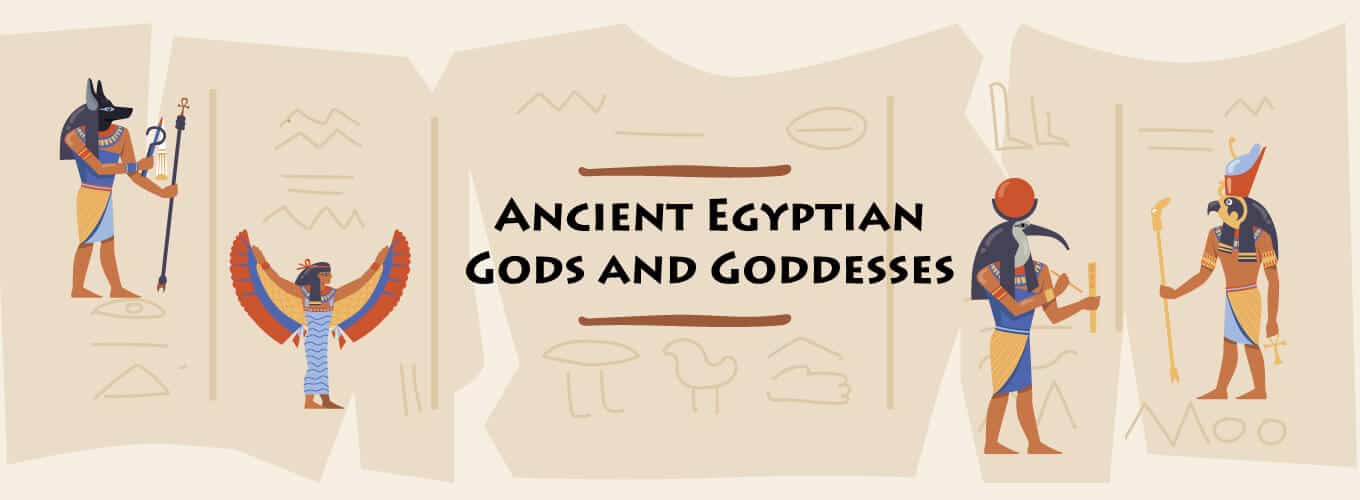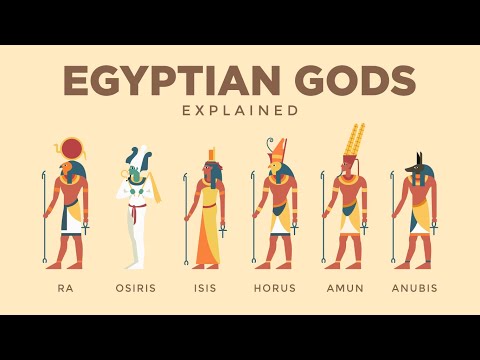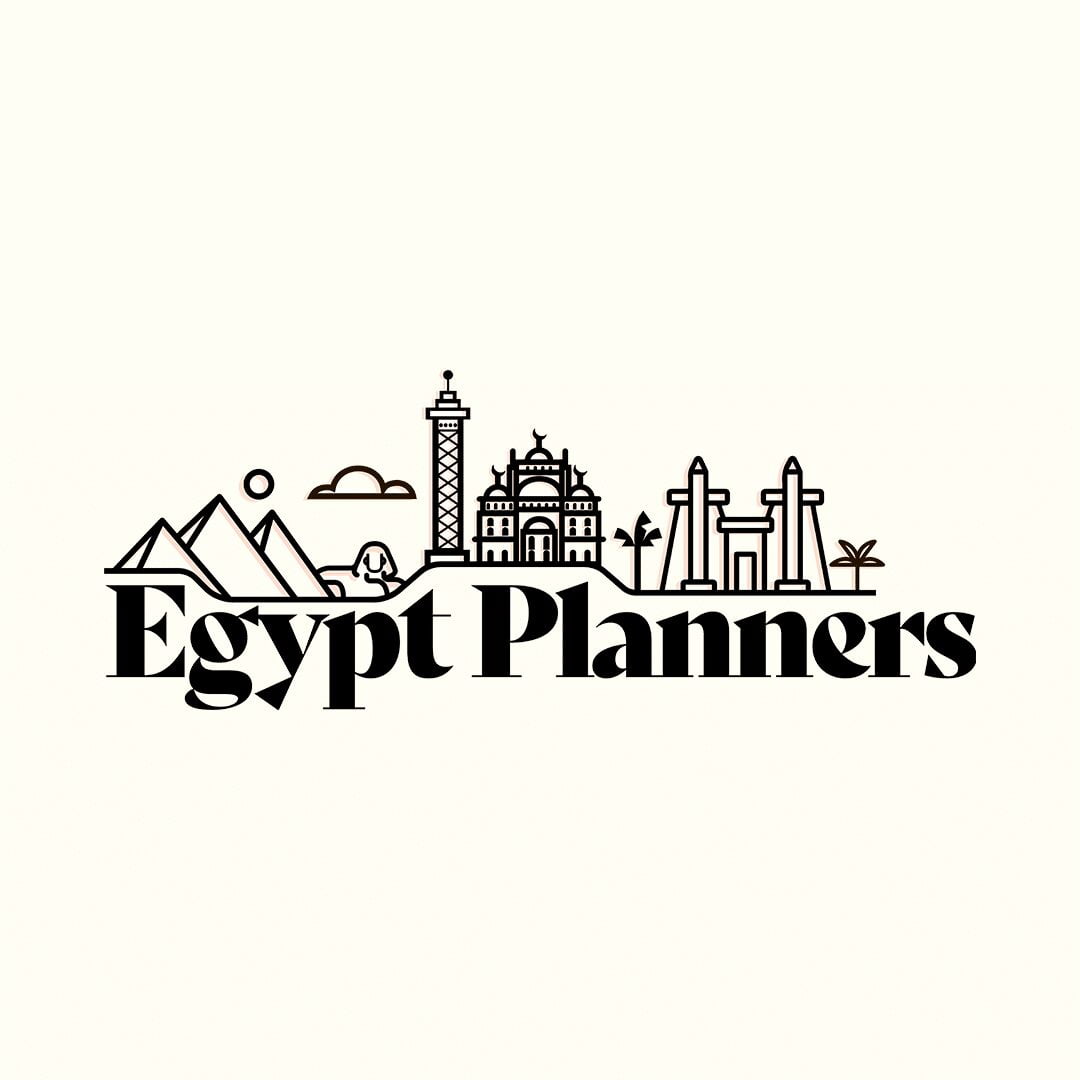Imagine uncovering the secrets of ancient Egyptian gods and goddesses and how their powers shaped civilization for over 3,000 years. Egyptians believed in a vast pantheon from Ra, the sun god, to Seth, the trickster. Explore Egyptian mythology and learn about these divine figures.
The ancient Egyptians worshipped over 1,400 gods and goddesses for three millennia. Each had special powers and roles in their society. Some gods, like Ra and Isis, were loved by all, while others were local favorites.
They believed gods ruled the world, from the sun to the afterlife. Ancient Egyptian Pharaohs, seen as gods on earth, kept balance with rituals and gifts. This kept the divine and mortal worlds in harmony.
The stories of ancient Egyptian gods still fascinate us today. They help us understand the rich mythology of this ancient civilization.
Key Takeaways
- Ancient Egyptian mythology featured over 1,400 revered figures, with 34 being the main deities.
- These gods and goddesses were responsible for all aspects of life, from the natural world to the afterlife.
- The pharaohs were considered divine representatives on Earth, with the gods playing a central role in their rule.
- Powerful deities like Ra, Osiris, Horus, and Anubis have left a lasting legacy and continue to captivate people worldwide.
- Understanding the ancient Egyptian pantheon provides insight into the rich culture and beliefs of this ancient civilization.
Don’t forget to check out the most important ancient Egyptian symbols and their meanings to learn about their relationship to the Egyptian gods.
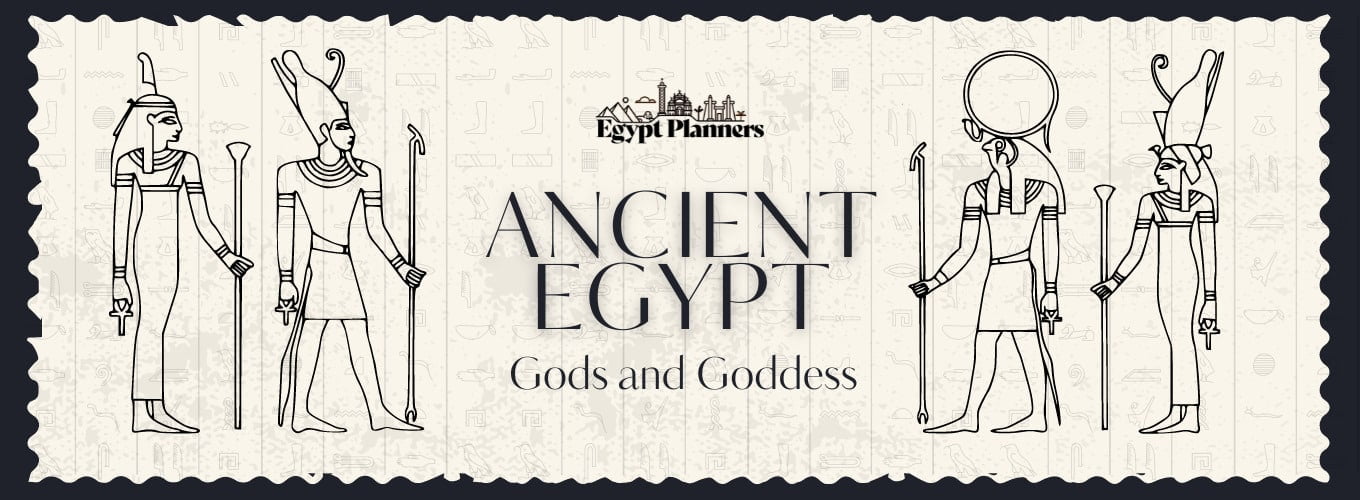
Introduction to Egyptian Mythology
The ancient Egyptian civilization was deeply rooted in a rich and complex mythology. It centered around a vast pantheon of gods and goddesses. These divine beings were believed to be responsible for all aspects of the natural and supernatural world.
They shaped the social, political, and cultural fabric of ancient Egyptian society.
The Significance of Gods and Goddesses in Ancient Egyptian Society
The ancient Egyptians held their gods and goddesses in the highest regard. The Pharaohs served as intermediaries between the mortal and divine realms. These deities were often depicted as a combination of human and animal forms.
Each represented a specific aspect of the world, such as the sun, the sky, the earth, or the afterlife.
The Origins and Evolution of Egyptian Religious Beliefs
The origins of Egyptian religious beliefs can be traced back to the Predynastic period (c. 5000-3100 BCE). The earliest records of these beliefs date to this time. Over the course of Egyptian history, the pantheon of gods and goddesses evolved.
New deities emerged, and others declined in importance. The worship of these divine beings was central to Egyptian religious practices. This is evident in the numerous temples, artwork, and rituals dedicated to them.
The ancient Egyptian mythology was a complex and intricate system of beliefs. It permeated every aspect of Egyptian society. The significance of gods and goddesses and the origins and evolution of Egyptian religious beliefs continue to captivate scholars and enthusiasts alike. They offer a glimpse into the rich cultural heritage of this ancient civilization.
List of Ancient Egyptian Gods and Goddesses
These gods and goddesses were key to ancient Egyptian life. They had unique powers and roles. Their worship lasted over 3,000 years, showing the deep and evolving nature of Egyptian mythology.
1- Ra – The Egyptian God of the sun, creation, and rebirth
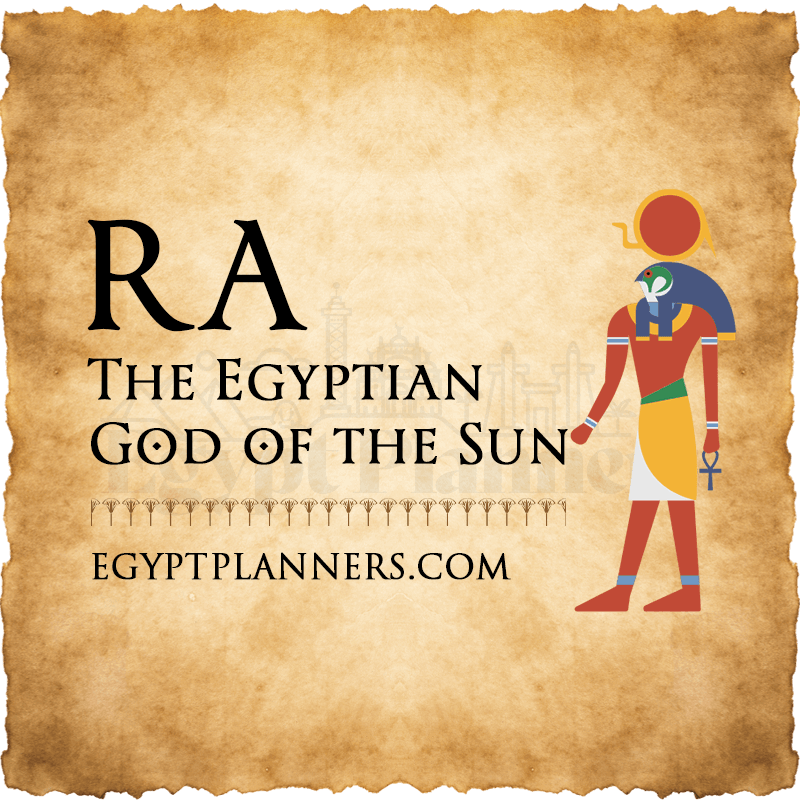
In ancient Egypt, Ra was a highly revered deity. He was seen as the sun god and the creator of the universe. His role as the sun god and king of the gods has lasted for centuries.
The cult of Ra started in the Fifth Dynasty, around 25th and 24th centuries BC. His worship lasted almost 2,000 years. Ra was thought to control the sky, Earth, and underworld. He was linked to Ma’at, which stood for order and balance.
The main place of worship for Ra was Heliopolis, known as the “city of the sun god.” The Mnevis bull, seen as Ra, was worshipped there. The Old Kingdom believed the king was the son of the Sun God, showing Ra’s key role in Egyptian royalty.
As Ra’s importance grew, so did his worship. Tombs showed his nightly journey through the underworld, fighting the serpent Apophis. The New Kingdom built pyramids, obelisks, and sun temples for him, making him the king of the gods.
Even as other gods like Amun rose, Ra’s impact stayed strong. Many gods were merged with Ra, like Amon-Ra, Khnum-Ra, and Sobek-Ra. This shows Ra’s lasting influence in ancient Egyptian religion.
“Ra was considered the greatest god in ancient Egypt, the creator of the universe and the giver of life, representing life, warmth, and growth.”
2- Isis – The Goddess of magic, motherhood, and fertility
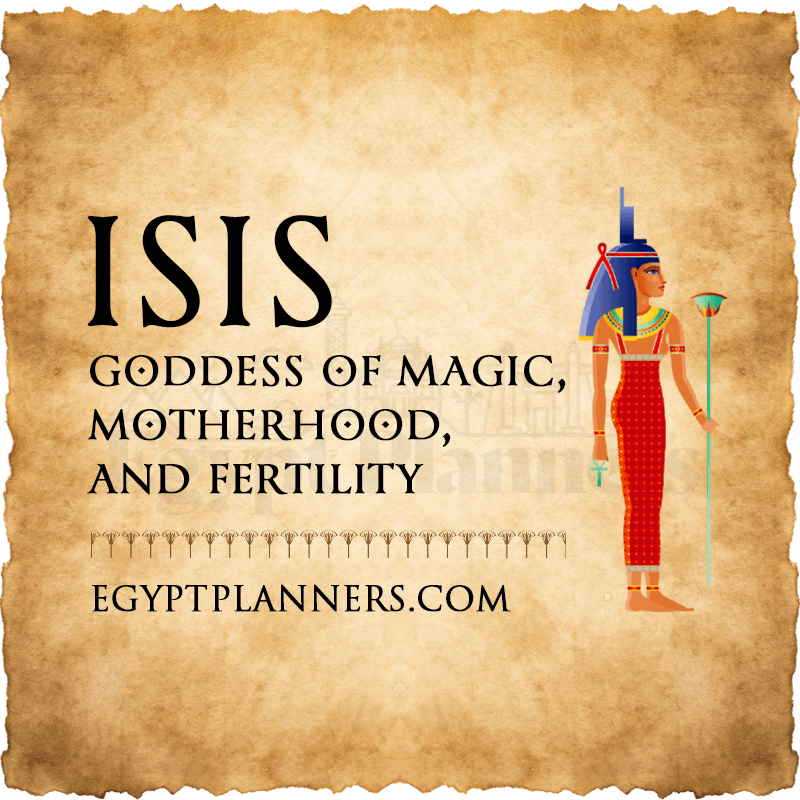
In ancient Egyptian mythology, Isis is a standout figure. She is the goddess of motherhood, magic, and Osiris’s wife. Her influence was huge, spreading across the Mediterranean. Her lasting popularity shows her deep importance in Egyptian culture.
Isis became key during the Old Kingdom (c. 2686 – c. 2181 BCE). She was central to the Osiris myth. Isis brought her husband Osiris back to life and protected their son Horus. This myth showed Isis’s complex role and her deep meaning in funerals.
Isis was seen as the goddess of motherhood and magic. She was often shown with a throne on her head, nursing Horus. This made her the ultimate loving mother and wife. The first temple for Isis was built by Nectanebo II (360–343 BCE) at Behbeit el-Hagar.
In the Hellenistic period (323–30 BCE), Isis became very popular in Egypt and Greece. Her worship spread far, even as Christianity grew. Isis’s influence might have shaped some Christian beliefs, like the Virgin Mary.
Today, Isis is still important in Western culture, especially in esotericism and modern paganism. She represents nature or the feminine divine. Her lasting impact on ancient Egyptian mythology and culture is clear.
3- Osiris – The God of the afterlife, rebirth, and farming
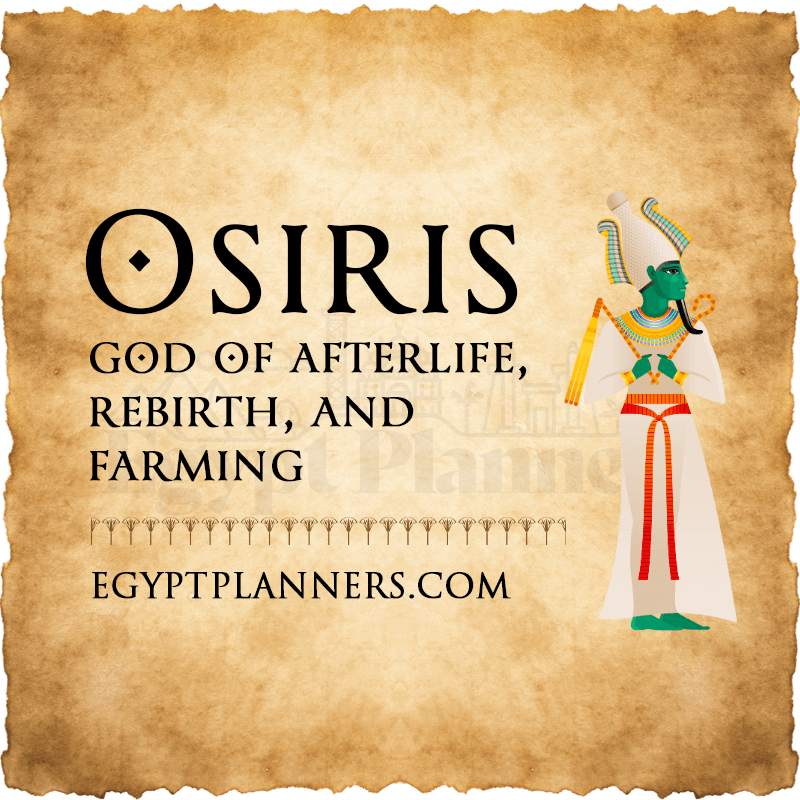
Osiris was a key god in ancient Egyptian mythology. He was linked to the afterlife and the idea of coming back to life. He was seen as the god of death, fertility, and farming, playing a big role in the beliefs of the ancient Egyptians.
The Myth of Osiris and Isis
Myth says Osiris was killed by his brother Seth. Seth tore him apart and spread his body parts everywhere. But Isis, Osiris’ wife, found and put him back together. This made Osiris the god of eternal life and the afterlife.
The Cult of Osiris and Its Importance
The cult of Osiris was big in ancient Egypt. Many temples were built for him, like the famous one at Abydos. Osiris was key in death and afterlife rituals, as Egyptians believed they had to pass tests to reach the afterlife.
Osiris was often shown as a mummified pharaoh. He held the crook and flail, symbols of his power. The osiris god of the afterlife and his resurrection were at the heart of the myth of osiris and isis and the cult of osiris.
| Fact | Value |
|---|---|
| Oldest known depiction of Osiris | About 2300 BCE |
| First evidence of Osiris worship | Middle of the Fifth Dynasty of Egypt (25th century BC) |
| Osiris’ role in ancient Egyptian religion | God of the afterlife, death, resurrection, and fertility |
| Cult centers of Osiris | Abydos and other vital locations |
4- Anubis – The God in charge of burials and funerals
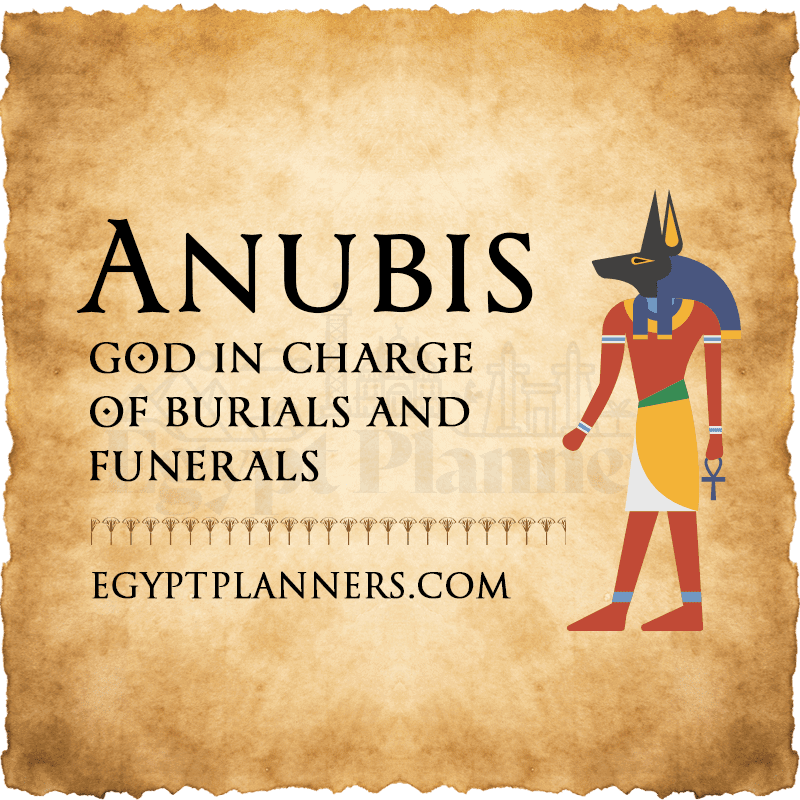
Anubis is a key figure in ancient Egyptian mythology. He is known as the jackal-headed god of mummification and the dead. His role was crucial in the funerary rites and afterlife beliefs of the ancient Egyptians.
The Role of Anubis in Funerary Rites
Anubis was in charge of the embalming and mummification process. He ensured the deceased’s body was properly preserved. He was often shown as a jackal-headed figure overseeing the mummification process.
This process involved removing organs, wrapping the body in linen, and applying oils and preservatives. Anubis also guided souls through the underworld to their final resting place. He guarded graves and cemeteries, preventing desecration.
Moreover, Anubis was responsible for the “Weighing of the Heart” ritual. In this ritual, he weighed a person’s heart against the feather of truth. This determined if they were worthy of the afterlife.
| Key Facts about Anubis | Details |
|---|---|
| Depiction | Anubis was depicted with a human body and the head of a jackal or a dog. |
| Titles | Anubis was known by various titles, including “The First of the Westerners,” “Lord of the Mummy Wrapping,” and “Chief of the Necropolis.” |
| Role | Anubis was the god of mummification, embalming, and the afterlife. He was responsible for guiding the souls of the dead to the afterlife. |
| Importance | Anubis was one of the most important gods in ancient Egyptian religion, and his cult was widespread throughout Egypt. |
Anubis was a significant deity in ancient Egyptian history. His temples and shrines were found throughout Egypt. As the anubis god of mummification and the jackal-headed god of the dead, Anubis was vital in the funerary rites and god of the dead beliefs of the ancient Egyptians.
5- Horus – The God of the sky, kingship, and protection
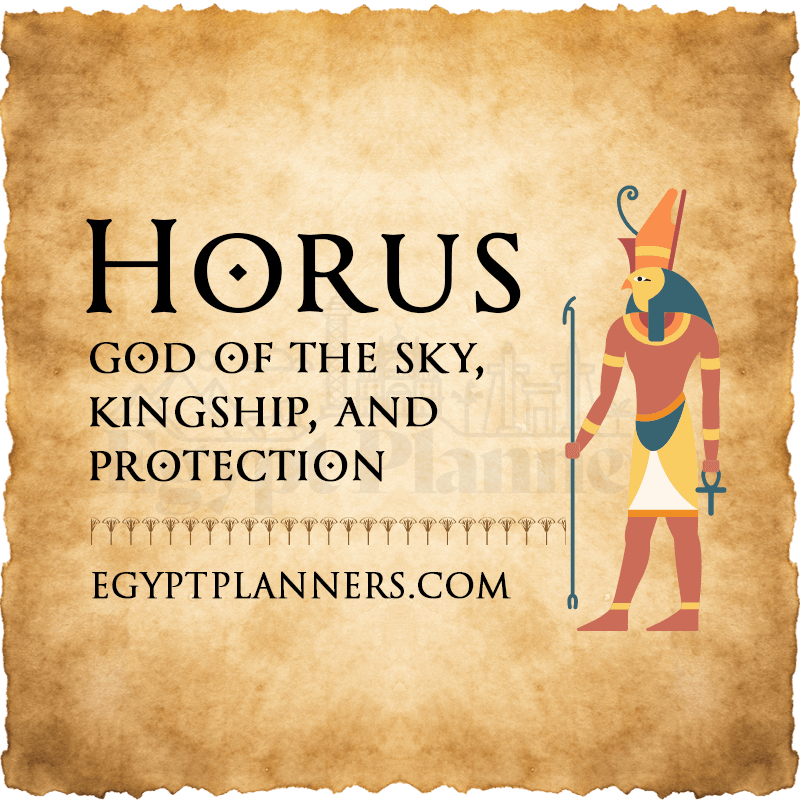
In ancient Egypt, Horus was a key god. He was shown as a man with a falcon’s head, wearing the double crown. This crown meant he was the king of all Egypt.
Horus was more than just a god. He was the sky god, controlling the sun and moon. He was also the god of kingship, healing, and protection. Pharaohs were seen as Horus on earth, showing his importance in Egypt.
Horus first appeared in Egypt’s late prehistoric period. He stayed important until the Ptolemaic Kingdom and Roman Egypt. Over time, different versions of Horus showed his many sides.
A famous story is Horus vs. Seth, the god of chaos. Horus fought to avenge his father, Osiris, and win Egypt’s throne. This story shows Horus as a hero and protector.
Many temples were built for Horus across Egypt. Places like Nekhen and Edfu showed his deep impact. The worship of Horus was a big part of Egyptian life.
6- Hathor – The Goddess of love, music, and happiness
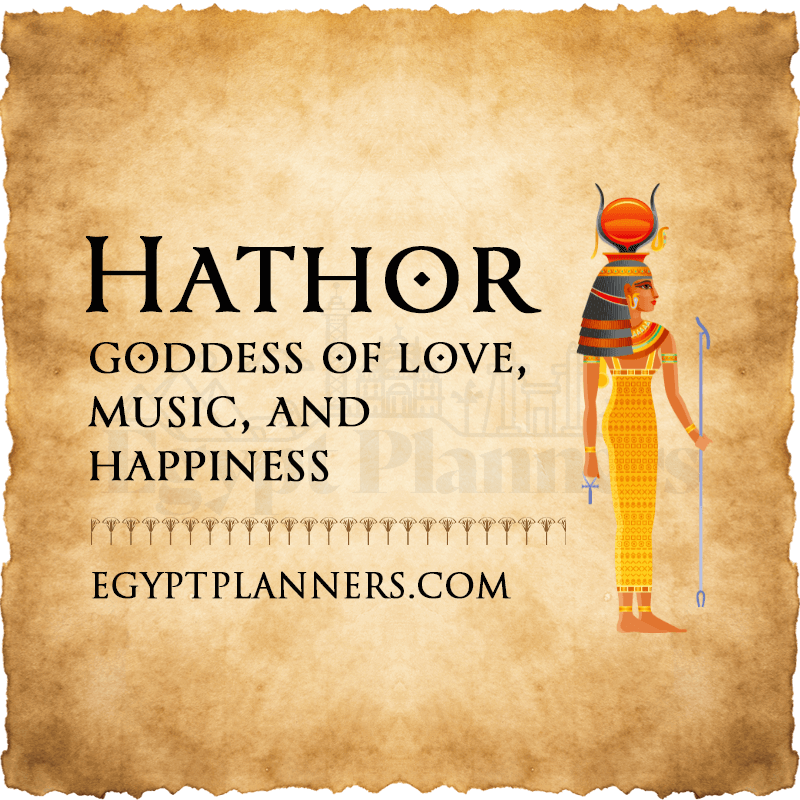
Hathor was a complex goddess in ancient Egyptian mythology. She was linked to love, beauty, music, and fertility. Women saw her as their protector during pregnancy and childbirth. Her temple at Dendera was a key religious site in ancient Egypt.
Hathor was shown in three ways: as a cow, a woman with cow ears, and a woman with a cow’s headdress and sun disk. She was Ra’s daughter and Horus’s wife, showing her dual nature.
The Dual Nature of Hathor: Benevolent and Destructive
Hathor was mostly known for her kind side. But, she also had a fierce side. Ra stopped her rampage after she punished humanity for its wrongdoings. In this form, she was a fierce lioness.
Hathor’s dual nature shows her complex character. She was loved for her beauty and fertility but also feared for her power. This reflects the ancient Egyptians’ deep understanding of the world and the divine.
| Hathor’s Attributes and Roles | Description |
|---|---|
| Goddess of Love, Beauty, and Fertility | Hathor was revered as the patron goddess of women, protecting them during pregnancy and childbirth. She was associated with love, beauty, and the pleasures of life. |
| Goddess of Music and Dance | Hathor was often depicted with musical instruments and was believed to preside over celebrations and joyous occasions. |
| Destructive Aspect as the Eye of Ra | In her darker manifestation, Hathor was depicted as a fierce lioness, capable of destroying humanity on the orders of the sun god Ra. |
| Multifaceted Nature | Hathor’s complex personality, encompassing both benevolent and destructive aspects, reflects the ancient Egyptians’ understanding of the duality inherent in the natural world and the divine. |
Hathor’s legacy as the hathor goddess of love, beauty, and fertility lasted for thousands of years. Her temple at Dendera was a major religious site until ancient Egyptian religion faded. Despite her dual nature, Hathor’s lasting impact shows her deep significance in ancient Egyptian mythology.
7- Thoth – The God of writing, learning, and knowledge
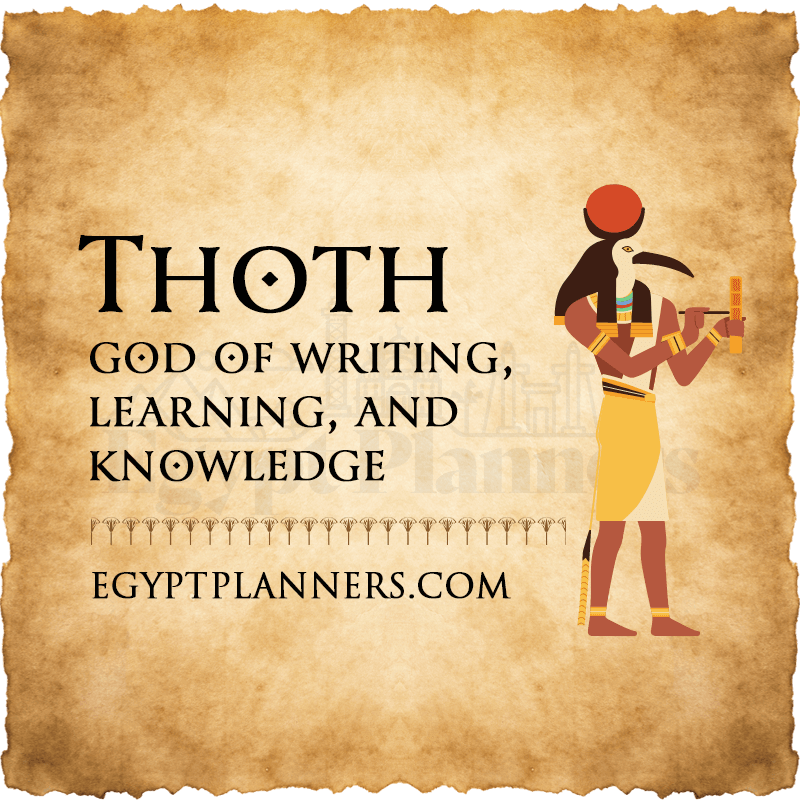
In ancient Egyptian mythology, Thoth is a key figure. He is often shown with an ibis bird’s head. Thoth was the god of knowledge, writing, and wisdom.
He was seen as the scribe of the gods and the protector of scribes and scholars. This made him very important in ancient Egypt.
Thoth was linked to the moon, giving him the power to measure time. He kept the gods’ records and upheld the principle of Ma’at. This principle stood for order, truth, and justice.
As the creator of hieroglyphics, Thoth played a crucial role in preserving ancient texts. This helped keep the written word alive.
“Thoth was the guardian of sacred texts and the protector of scribes and intellectuals.”
Thoth’s temple at Hermopolis Magna was a hub for learning. Scholars from all over Egypt came there. His wisdom and knowledge made him a highly respected figure.
- Thoth was identified with the Moon god Iah-Djehuty, symbolizing the Moon for the entire month.
- Thoth was credited with the creation of the 365-day calendar in Egyptian mythology.
- Thoth was associated with the invention of writing and Egyptian hieroglyphs.
- Thoth was the patron god of scribes, who would honor him before beginning their work.
As the thoth god of knowledge and the ibis-headed god, Thoth’s influence was vast. His wisdom was sought in learning and sacred rituals. His legacy shows the importance of knowledge and writing in ancient Egyptian society.
8- Bastet – The Goddess of protection, happiness, and fertility
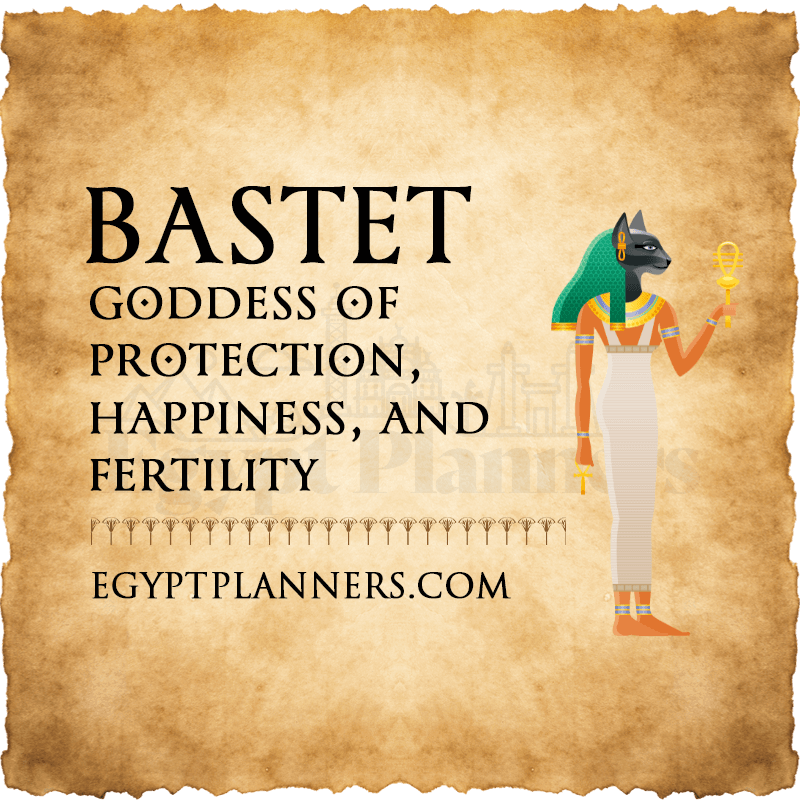
In ancient Egypt, Bastet was a unique feline goddess. She was known for protection, fertility, and beauty. At first, she was seen as a fierce lioness. Later, her image changed to show her as a cat or a woman with a cat’s head.
Bastet’s home was in Bubastis, in the western Nile Delta. Her temple was filled with cats. These cats were highly respected. When they died, they were mummified and buried in a huge cemetery.
Bastet was seen as a protector. She kept homes safe from evil spirits and animals. She was also linked to the moon and fertility. This made her very popular, especially during a big festival in Bubastis.
“Bastet was venerated and feared alike, holding titles such as The Lady of Dread and The Lady of Slaughter.”
Over time, the bastet goddess of cats became more gentle. Her story still fascinates us today. The cat remains a beloved animal in Egyptian culture and myths.
9- Set – The God of chaos, the desert, and storms
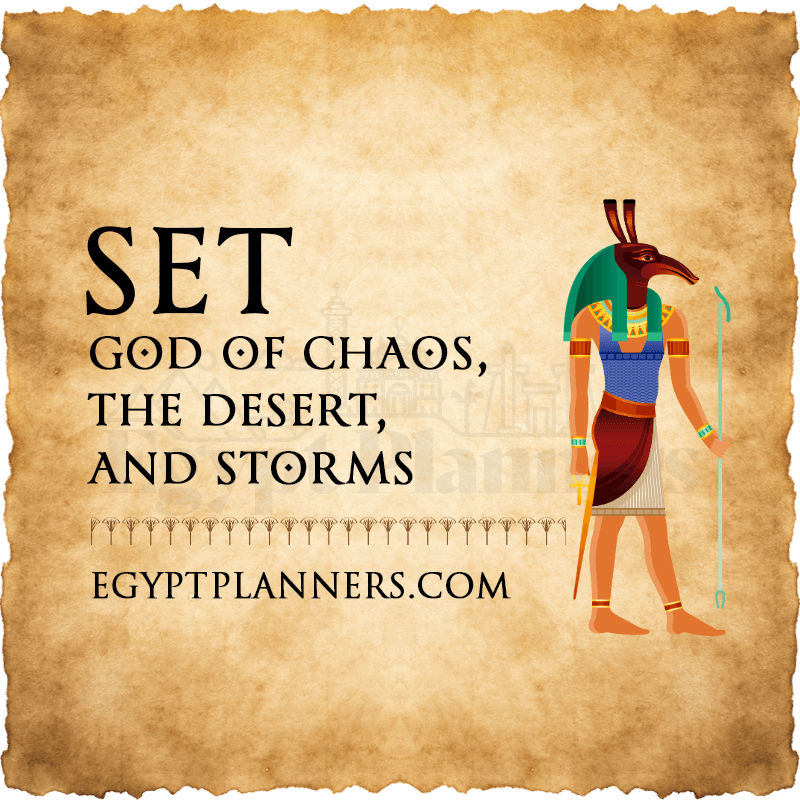
In ancient Egyptian mythology, Seth was a complex and controversial deity. He was seen as the god of war, chaos, and storms. Seth was often depicted with the head of an unknown animal. He was the brother and rival of Osiris, the god of the afterlife and resurrection.
Myths say Seth killed Osiris out of jealousy. This made him a symbol of evil and disorder. Yet, Seth was also seen as a powerful protector of the pharaohs and the Egyptian people.
He was associated with the harsh desert environment. It was believed he could repel evil spirits and safeguard travelers. Seth was also known for controlling storms and natural disasters, commanding the winds and weather.
The significance of Seth in Egyptian mythology changed over time. He was sometimes seen as evil, but also as a necessary force for balance and order. Seth’s role as the protector of the sun god Ra was notable. He was depicted standing on Ra’s barge to defeat the dark serpent Apep.
| Key Facts About Seth | Details |
|---|---|
| Worship and Depiction | Seth was worshipped as a sky god, lord of the desert, and master of storms, disorder, and warfare. He was often depicted with the head of an unknown animal. |
| Origins and Rise | During the 2nd dynasty (c. 2775–c. 2650 BCE), King Peribsen identified himself with Seth for the first time. Seth’s image as a martial god was further strengthened during the New Kingdom (1539–c. 1075 BCE). |
| Relationship with Osiris | In Egyptian mythology, Seth was the brother of Osiris and was believed to have murdered him out of jealousy. This made Seth a symbol of chaos and evil. |
| Decline and Demonization | In the 1st millennium BCE, Seth was gradually ousted from the Egyptian pantheon due to the growing prominence of the cult of Osiris. During the Late and Graeco-Roman periods, he was demonized and identified with the Greek monster Typhon. |
Despite his complex and often negative portrayal, Seth remained an important figure in ancient Egyptian mythology. He served as a protector of the pharaohs, soldiers, hunters, and merchants. Seth played a crucial role in maintaining the cosmic balance.
10- Sekhmet – Goddess of War, Healing, and Revenge
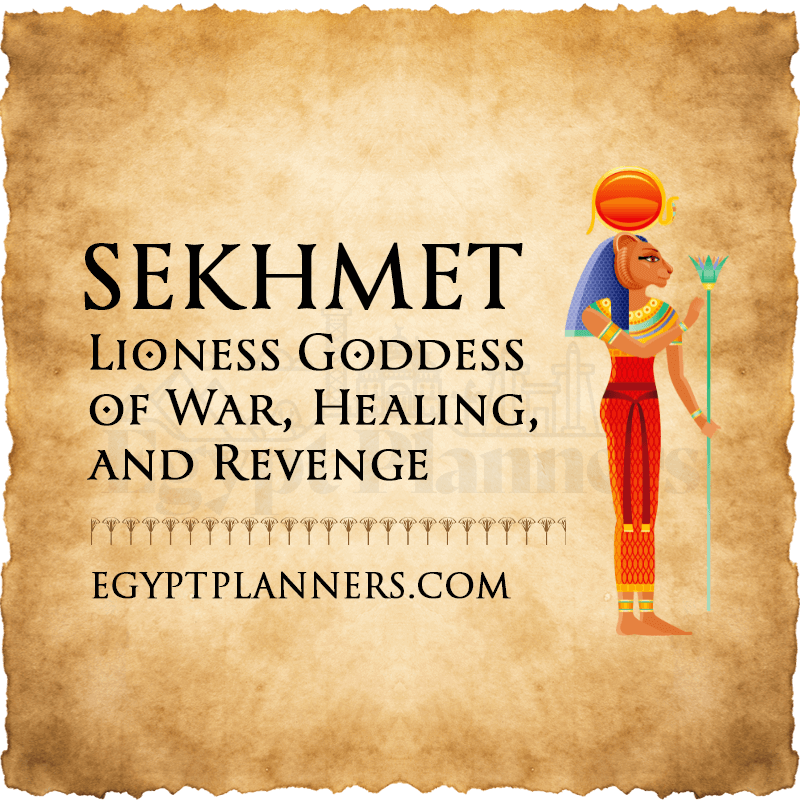
Sekhmet was a key figure in ancient Egyptian mythology. She was seen as a woman with a lioness’s head, wearing the sun disk and uraeus (the rearing cobra). This made her the daughter of the sun god Ra. Sekhmet was linked to the sun’s dangerous and healing sides.
As the goddess of war, Sekhmet protected Pharaohs in battle and punished their foes. Her fierce nature was feared, and she could bring plagues and diseases. Yet, she was also known for healing, curing ailments and illnesses.
The cult of Sekhmet was in Memphis, with a huge temple complex. Festivals in her honor drew tens of thousands. They drank lots of beer and wine. Sekhmet’s mix of destruction and healing shows the ancient Egyptians’ deep understanding of life and death. Her legacy as a fierce lioness goddess of war still inspires many today.
11- Ptah – The God of making and building things
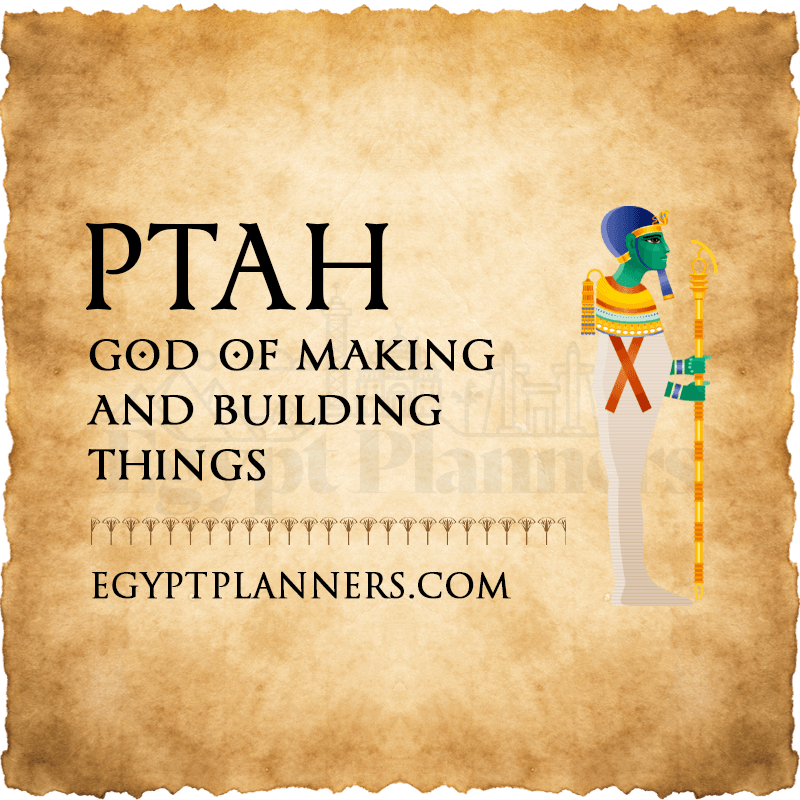
In ancient Egypt, Ptah was a god of great importance. He was known as the god of craftsmanship, architecture, and creation. As the ptah egyptian god of craftsmen, he watched over artisans, builders, and architects. They built grand monuments that still stand today.
Ptah was also the ptah god of architecture. He was shown as a man in a tight shroud, symbolizing his role as a creator. He was thought to have made all gods and the universe, showing his immense power.
The ptah god of builders was linked to the pharaohs, who were seen as Ptah’s earthly forms. His main temple was in Memphis, and temples were found all over Egypt. This shows how much people revered him. Ptah was also the ptah god of creation, with powers beyond the physical world.
Ptah’s worship wasn’t just in Egypt. It was also found in the Eastern Mediterranean, like in Carthage. This shows how deeply he influenced people, even outside Egypt. His legacy still fascinates scholars and fans today.
12- Nephthys – The Goddess of sorrow, security, and the night sky
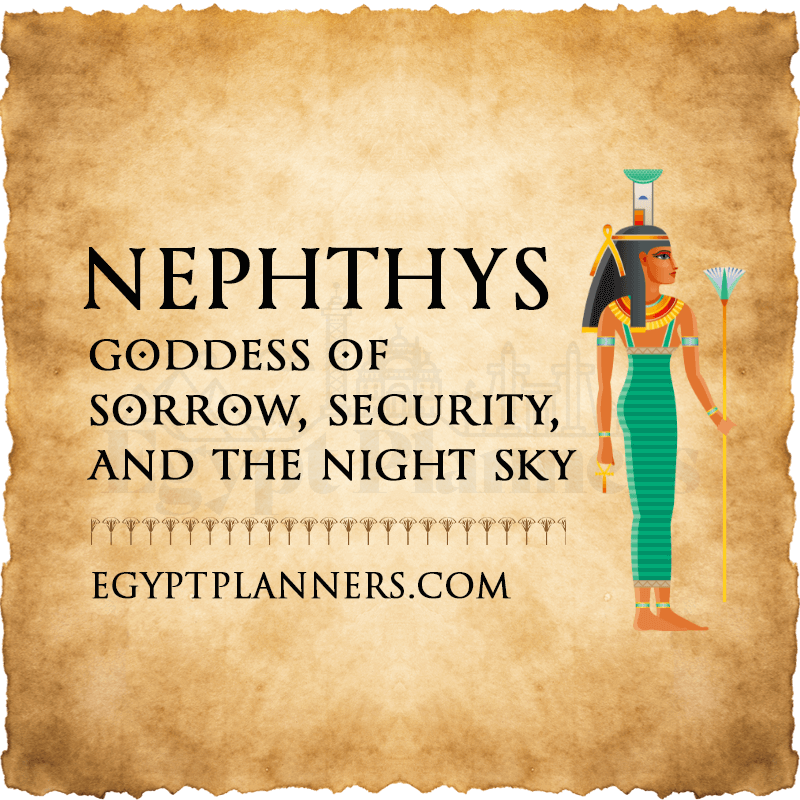
In ancient Egyptian mythology, Nephthys was a goddess of great importance. She was linked to sorrow, security, and the night sky. Her role was complex and vital to the ancient Egyptians’ beliefs and practices.
Nephthys was Isis, Osiris, and Set’s sister. She was often shown with her name on her head. Her marriage to Set was complicated. She was seen as a protector of both the dead and the living.
She played a key role in funerary rituals. Nephthys helped Anubis in mummification, guiding souls to the afterlife. Her connection to the night sky and moon made her a guardian of the dead.
Nephthys was revered for her security and protection. She had temples and rites dedicated to her. Her spells were crucial for the afterlife journey. She was also a nursemaid and guardian of Horus, showing her kindness and respect.
Despite her complicated relationship with Set, Nephthys was essential in ancient Egyptian mythology. Her bond with Isis and her role in Osiris’s resurrection solidified her importance.
| Aspect | Description |
|---|---|
| Nephthys as a Goddess | Nephthys was associated with various aspects, including mourning, night/darkness, service in temples, childbirth, the dead, protection, magic, health, embalming, and beer. |
| Family Ties | Nephthys was the daughter of Nut and Geb, and was usually paired with her sister Isis in funerary rites. |
| Protective Qualities | Nephthys was a protective goddess symbolizing the death experience and was known as the “Helpful Goddess” or the “Excellent Goddess.” |
| Relationship with Anubis | Nephthys was regarded as the mother of the funerary deity Anubis in some myths. |
| Iconography | Nephthys was depicted as a kite or a woman with falcon wings, symbolizing protection and often associated with death and putrefaction in the Pyramid Texts. |
| Importance in Afterlife | Nephthys was considered a necessary companion for the journey to the afterlife, along with Isis, and her magical spells were essential for navigating the afterlife. |
13- Sobek – The God of the Nile, fertility, and strength
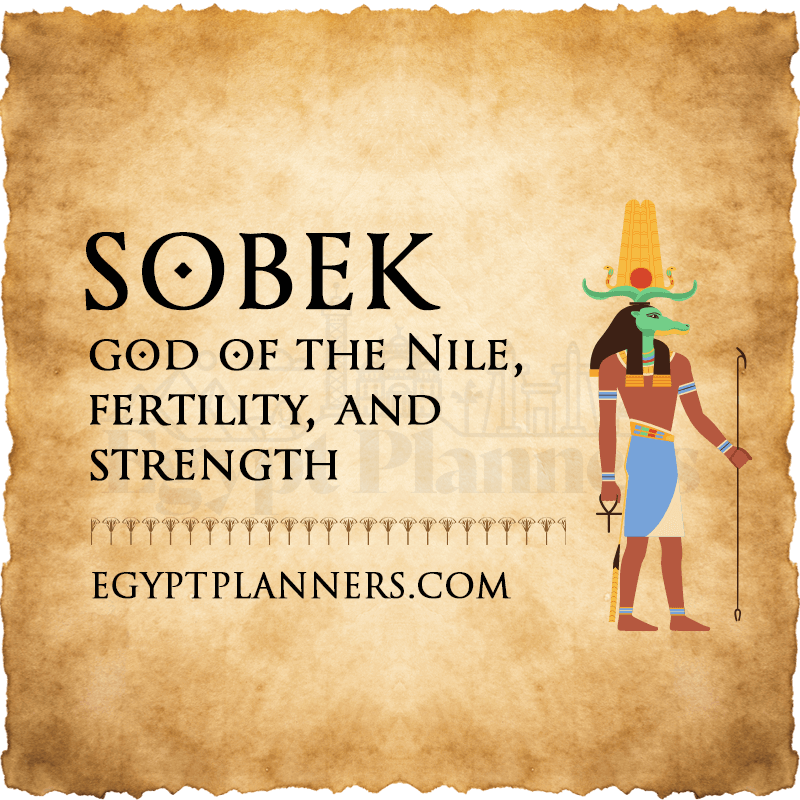
Sobek was a powerful god in ancient Egypt, linked to the Nile River, fertility, and strength. He was known for his crocodile head and was important from the Old Kingdom to the Roman period.
During the Middle Kingdom, Sobek’s fame grew, especially under Pharaoh Amenemhat III. He was combined with Horus, the god of kings, making him even more important. Later, Sobek was merged with Ra, the sun god, as Sobek-Ra. This showed the unity of the Nile and the sun in sustaining life.
The Faiyum was Sobek’s main worship place, with towns like Soknebtunis and Souxei honoring him. Crocodilopolis, in the Faiyum, was key for Sobek, especially Sobek Shedety. It saw many building projects over time.
Sobek was seen as a god of fertility and abundance because of his link to the Nile. He helped Isis with Horus’s birth, showing his role in fertility and renewal. He was also a protector of Pharaohs, ensuring their safety and success.
Sobek’s crocodile form showed his fierce and protective side. The ancient Egyptians both admired and feared him, knowing the Nile crocodile’s power in their lives.
Sobek’s lasting impact on ancient Egypt shows his crucial role in their lives. As a god of the Nile, fertility, and strength, he shaped their culture and religion.
14- Maat – The Goddess of truth, justice, and unity
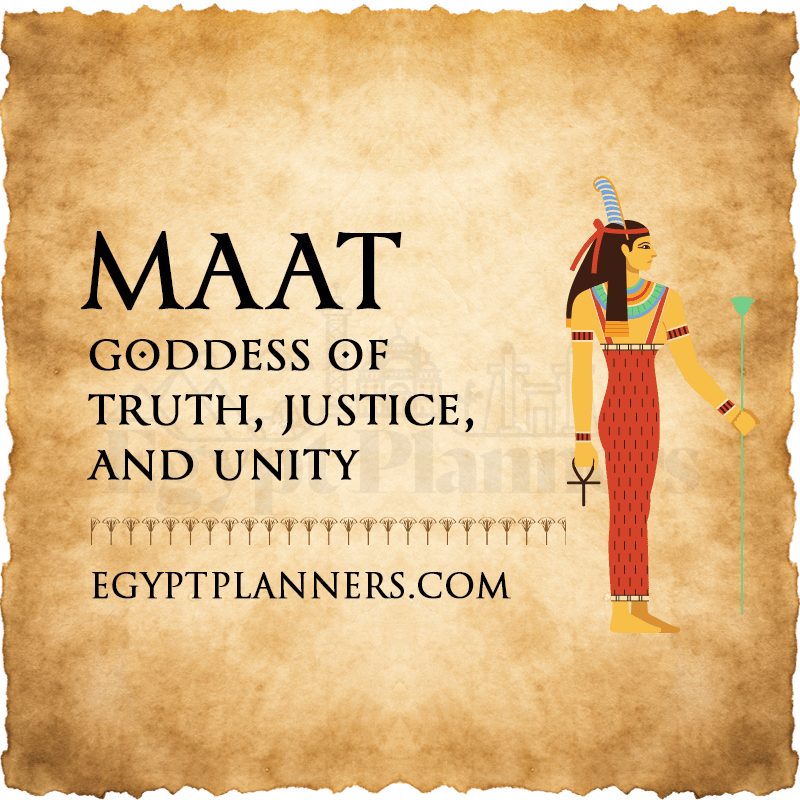
In ancient Egyptian mythology, Maat was a highly revered goddess. She represented truth, justice, and unity. She was often shown as a woman with an ostrich feather on her head. This feather symbolized her role in the afterlife, where she weighed hearts against truth.
Maat was believed to be the daughter of the sun god Ra. She was seen as the personification of cosmic order and balance. She was central to the concept of Maat, which included moral and physical laws.
Maat was invoked in religious ceremonies and rituals. Her image was often found in tombs and temples. She played a crucial role in the Weighing of the Heart ceremony, where hearts were weighed against her feather.
Pharaohs often showed themselves with Maat’s emblems to highlight their commitment to laws and righteousness. Maat’s significance extended to all aspects of existence. She ensured equilibrium in the universe, religious observances, and truthfulness in social interactions.
The concept of Maat was central to Egyptian law. It was based on maintaining order and preventing chaos in society. Viziers responsible for justice were known as the Priest of Maat, emphasizing the importance of applying justice in the spirit of truth and fairness.
Maat and her associated values of truth, justice, and unity were described as the foundations of Egyptian civilization. Her enduring legacy as a symbol of ethical and moral principles underscores the profound impact she had on ancient Egyptian culture.
| Key Facts about Maat | Significance |
|---|---|
| Goddess of truth, cosmic balance, and justice | Personified the ethical and moral principles that governed ancient Egyptian society |
| Daughter of the sun god Ra | Symbolized the belief that pharaohs ruled through the authority of Maat |
| Weighed the hearts of the dead against her feather in the afterlife | Determined the decedent’s entry into the afterlife based on their adherence to Maat |
| Depicted as a woman with an ostrich feather | The feather represented truth, harmony, and balance |
| Central to the concept of Maat, which encompassed moral and physical laws | Ensured the stability of society and the natural world |
15- Amun – The God of creation, air, and wind
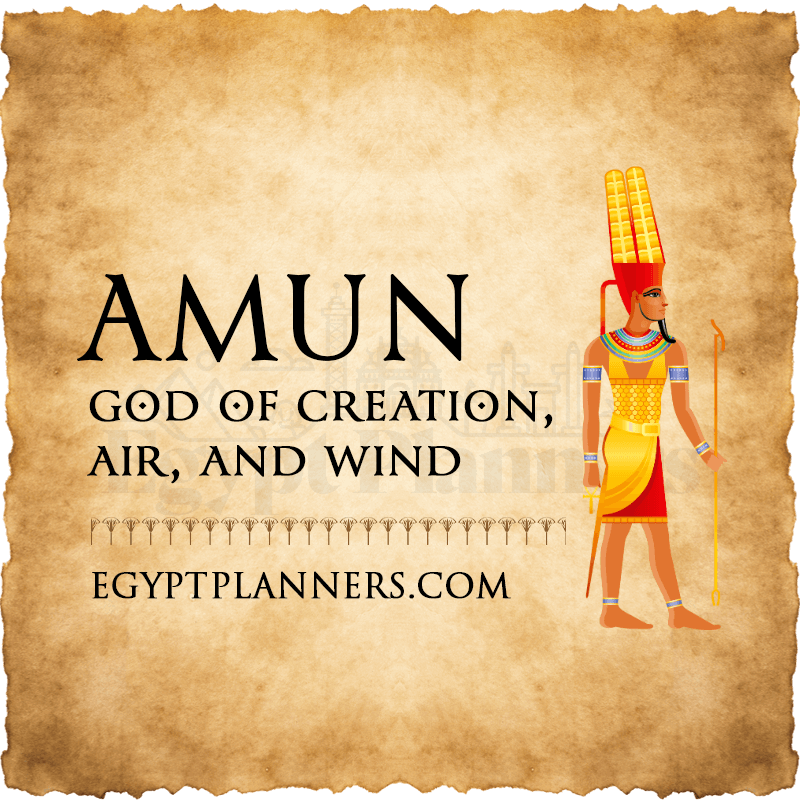
In ancient Egypt, Amun was a god like no other. He was known as the hidden one and king of the gods. Amun was more important than gods like Ra, Ptah, Bastet, and Anubis. His power and importance grew over time, making him a key figure in Egyptian religion.
The Rise of Amun-Ra and His Significance
Amun started as a local god in Thebes but soon became a national god. He was linked with fertility and the sun. By the New Kingdom (1539–c. 1075 BCE), Amun was tied to Egypt’s politics, with his temple in Karnak at its center.
Amun merged with Ra, becoming Amun-Ra. Amun-Ra was seen as a creator god during the New Kingdom. His influence went beyond Egypt, reaching the western desert oases. His temple at Karnak was massive and wealthy, showing his lasting power.
“Amun was the king of the gods, the god of the air, the god of fertility, and the god of hidden things.”
Amun-Ra kept his influence even as other gods changed. His rise shows how Egyptian religion focused on a single, powerful god. This legacy still affects us today.
16- Tawaret – The Goddess of childbirth and protection
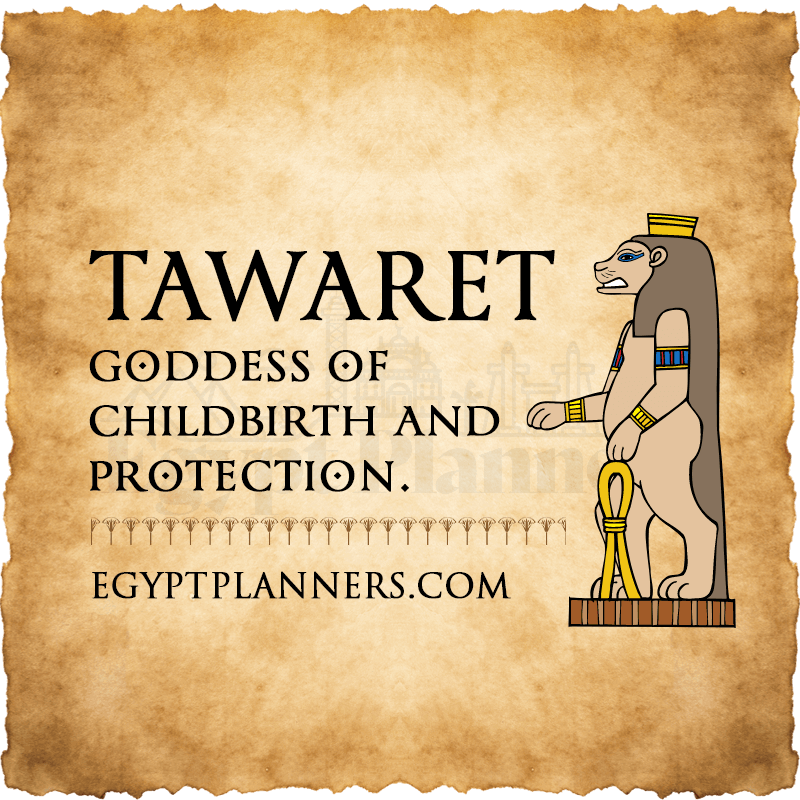
In ancient Egypt, Tawaret was a unique goddess. She was linked to childbirth, fertility, and protecting mothers and kids. Her hippopotamus head showed her strength against evil forces.
People in Thebes worshipped Tawaret as a caring goddess. They used her image in amulets to keep babies safe. This was crucial because many babies died young in ancient Egypt.
The Egyptians worked hard to keep mothers and babies safe. They buried almost half of all graves with children. Doctors, called swnw, used old medical texts to help.
Tawaret’s look was powerful, mixing hippopotamus, crocodile, and lion traits. This showed her ability to protect the weak. Amulets with her image were found from the earliest times.
Even in later times, Tawaret was important to Egyptians. Her image was on many household items. The tawaret hippopotamus goddess showed the Egyptians’ dedication to family safety. Her story still moves and inspires us today.
17- Khepri – God who stood for the rising sun, creation, and rebirth
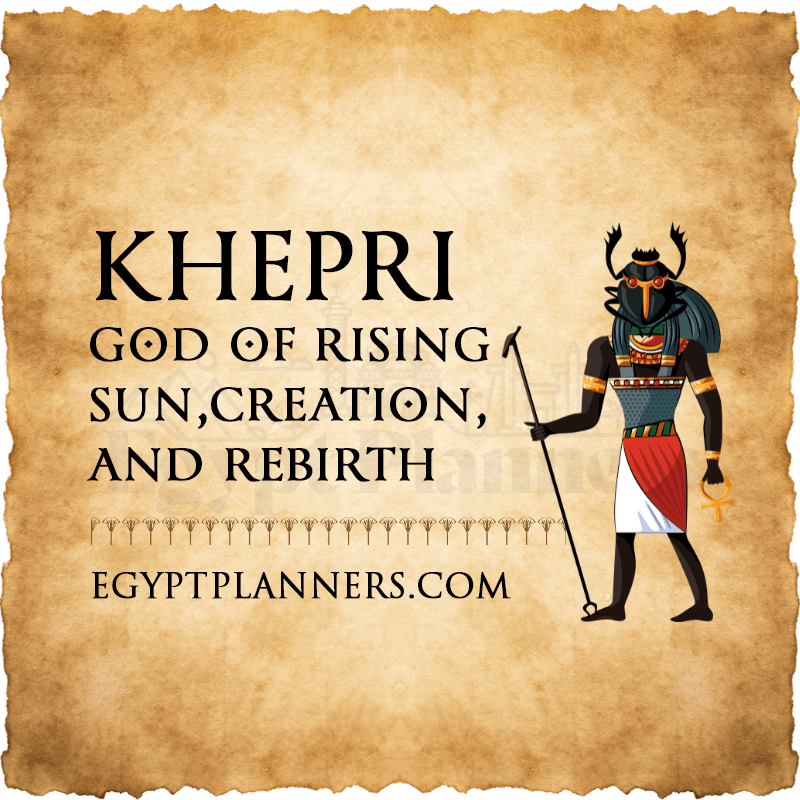
In ancient Egypt, Khepri was a key deity. He was linked to the sun, creation, and rebirth. He was often shown as a scarab beetle or a man with a beetle head. His symbols came from nature’s wonders.
The Egyptians admired the scarab beetle’s life cycle. Young beetles came out of dung balls fully formed. This was like Khepri’s birth from chaos. He was seen as rolling the sun across the sky, just like the beetle pushes its dung ball.
Khepri’s name means “he who has come into being.” This shows his link to creation and renewal. Every morning, he was seen as the god of life, death, and rebirth. This was key to ancient Egyptian beliefs.
The scarab beetle was very important to the Egyptians. They made amulets and talismans in its shape. These were buried with mummies for protection. The heart scarab was special, placed over the heart of the deceased with spells from the Book of the Dead.
Khepri’s role in ancient Egypt was huge. He was the god of the sun, creation, and rebirth. His legacy still fascinates scholars and fans today.
18- Nut – The Goddess of the sky and the whole universe
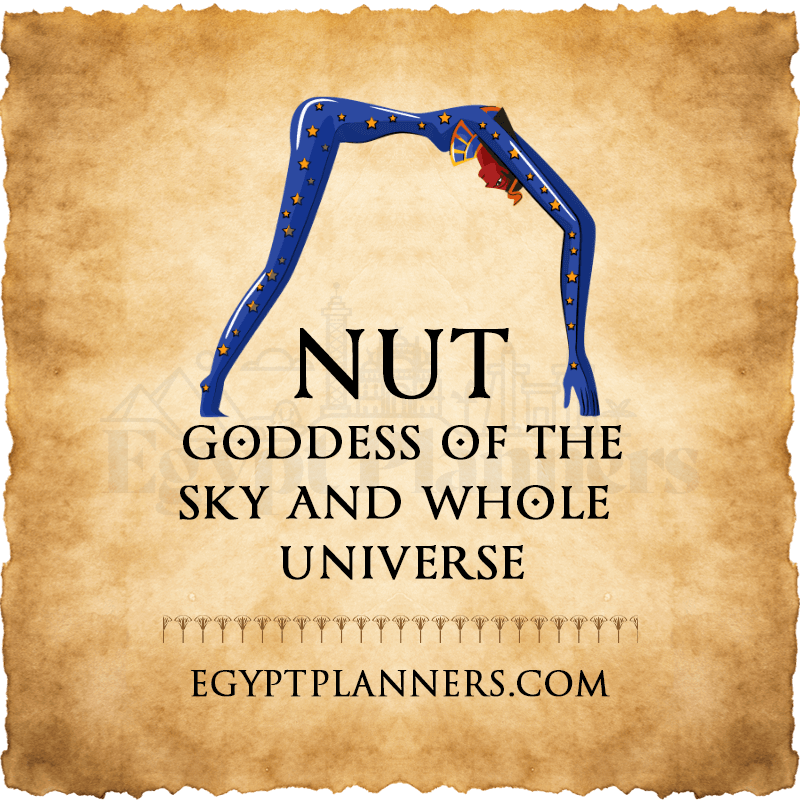
In ancient Egyptian mythology, Nut was a powerful goddess. She was linked to the sky, the universe, and cosmic order. Her body was seen as a woman stretching across the heavens, with her limbs marking the cardinal points.
Nut was believed to swallow the sun god Ra every evening. Then, she gave birth to him again each morning. This act symbolized the daily cycle of the sun.
As the mother of Osiris, Isis, Seth, and Nephthys, Nut was key in the Egyptian pantheon. She was seen as a protector of the dead. Her image was often found on tomb ceilings and coffin lids.
Nut’s role in the sky and cosmos was vital to the ancient Egyptians. It helped them understand the natural world and their place in it.
Nut was known by many titles, like “Coverer of the Sky” and “Mistress of All.” Her body was covered in stars at night, showing her role as the sky. She was a friend and protector of the dead, guiding them into her star-filled sky.
19- Shu- The Egyptian God of air, light, and order
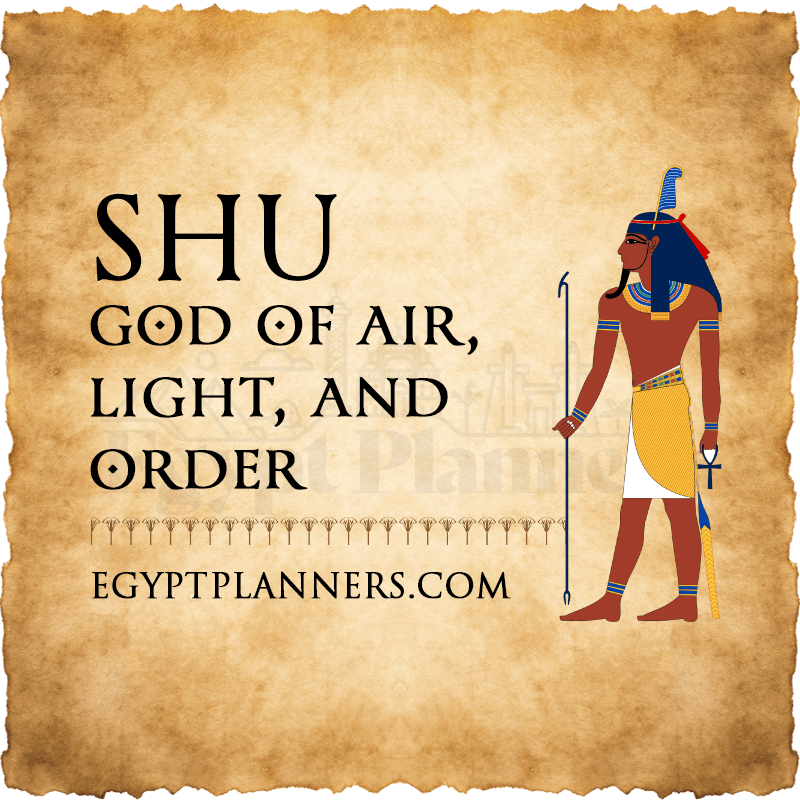
In ancient Egyptian mythology, Shu is a key figure. He represents air, light, and order. As a primordial god, Shu deeply influenced Egyptian beliefs and traditions.
Shu is shown as a man with an ostrich feather headdress. This symbolizes lightness and emptiness. He separated the sky goddess Nut from the earth god Geb. This act allowed for life and the separation of the heavens and earth.
Shu is also linked to air, wind, and sunlight. He was seen as a calming force, keeping balance with Ma’at. This balance is about truth, justice, and order. Shu’s kindness and role in maintaining order made him highly respected.
During the New Kingdom era, Shu’s importance grew. His solar connections became more clear. He was often shown with his wife, Tefnut. Together, they created the sky and earth.
Shu’s legacy still fascinates those who study ancient Egyptian mythology. His role in their cosmology shows the depth and complexity of their beliefs.
| Shu’s Attributes | Shu’s Associations |
|---|---|
| Ostrich Feather Headdress | Air, Wind, Lightness |
| Was Scepter and Ankh | Strength, Life, Renewal |
| Standing on the Body of Geb | Separation of Sky and Earth |
| Lion-Headed Form | Strength, Courage, Nobility |
“Shu, the god of air, was revered for his role in separating the sky from the earth, allowing for the existence of life itself.”
20- Geb – The God of the Earth and fertility
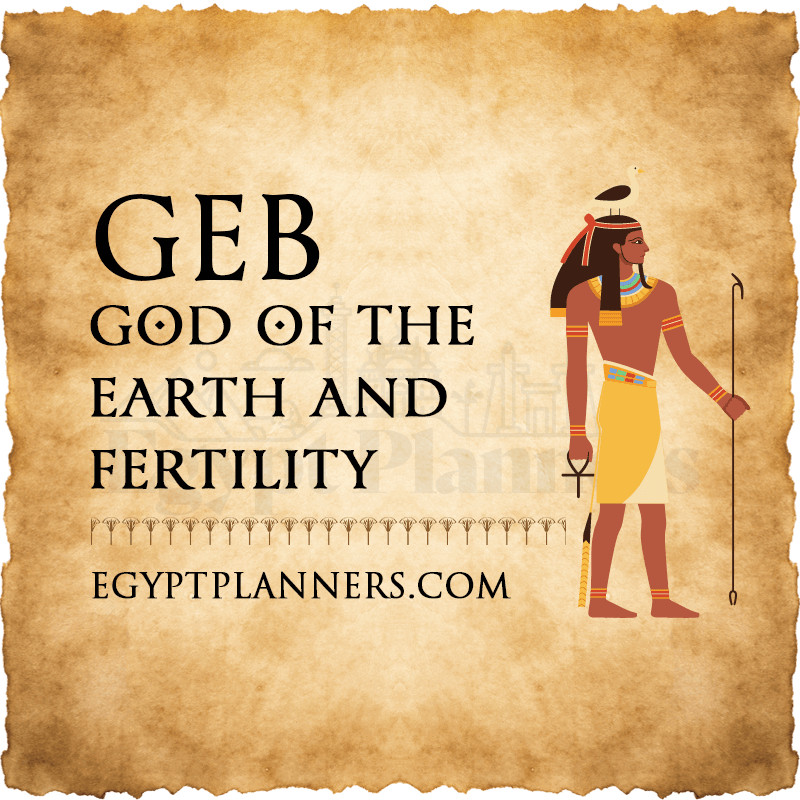
In ancient Egypt, Geb was seen as the god of the Earth and fertility. He was the father of important deities like Osiris and Isis. Geb was believed to be the first ruler of Egypt, making him a key figure in Egyptian mythology.
Geb was often shown lying down, with green skin to symbolize the Earth’s fertility. The ancient Egyptians thought earthquakes were caused by Geb’s laughter. They made many offerings to him, especially during the Harvest Festival and the New Year, Wepet-Renpet.
Geb was linked to a goose on his head, showing his connection to the land. He was married to the sky goddess Nut. Together, they played a big role in the Egyptian pantheon. Geb’s influence was seen in farming, fertility rituals, and seasonal festivals.
“Geb’s laughter was believed to create earthquakes in ancient Egypt.”
Even though there’s debate about Geb’s origins, his importance as the god of the Earth and fertility is clear. His connection to the land and its cycles still fascinates people today. It shows the deep impact of ancient Egyptian gods on their civilization.
21- Tefnut – The Goddess of rain and wetness
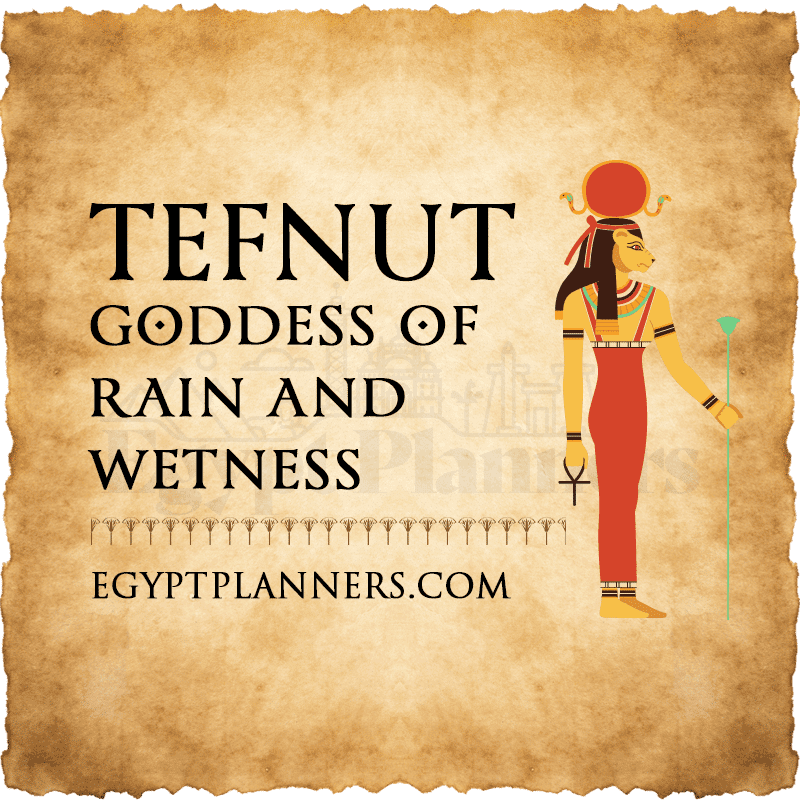
In ancient Egyptian mythology, Tefnut was a key figure. She was known as the tefnut egyptian goddess of rain, moisture, and wetness. Her role was vital in the cycle of life and the nourishment of the land.
Her story begins in the Heliopolitan creation myth. Born from Atum’s sneeze or spit, she was the sister and wife of Shu, the air god. Together, they balanced the wet and dry aspects of creation. They were key in separating the sky goddess Nut from the earth god Geb.
Tefnut was often shown as a lioness, a human with a lioness head, or a human with a solar disk and uraeus serpent. This imagery highlighted her ties to the sun, water, and nature’s forces.
“Tefnut, the goddess of rain and wetness, was a central figure in maintaining cosmic harmony and regulating the essential water supply for ancient Egypt’s prosperity.”
As part of the Ennead of Heliopolis, Tefnut was worshipped in Heliopolis and Leontopolis. She was revered alongside her brother-husband, Shu. Her role as a goddess of wetness was crucial. She brought rain, dew, and moisture to the land, ensuring agriculture thrived and the people were well.
Tefnut’s importance went beyond rain and wetness. She was also linked to the Eye of Ra, a powerful aspect of the sun god. This further connected her to the divine forces that kept life alive in ancient Egypt.
22- Anuket – The goddess of the Nile and agriculture
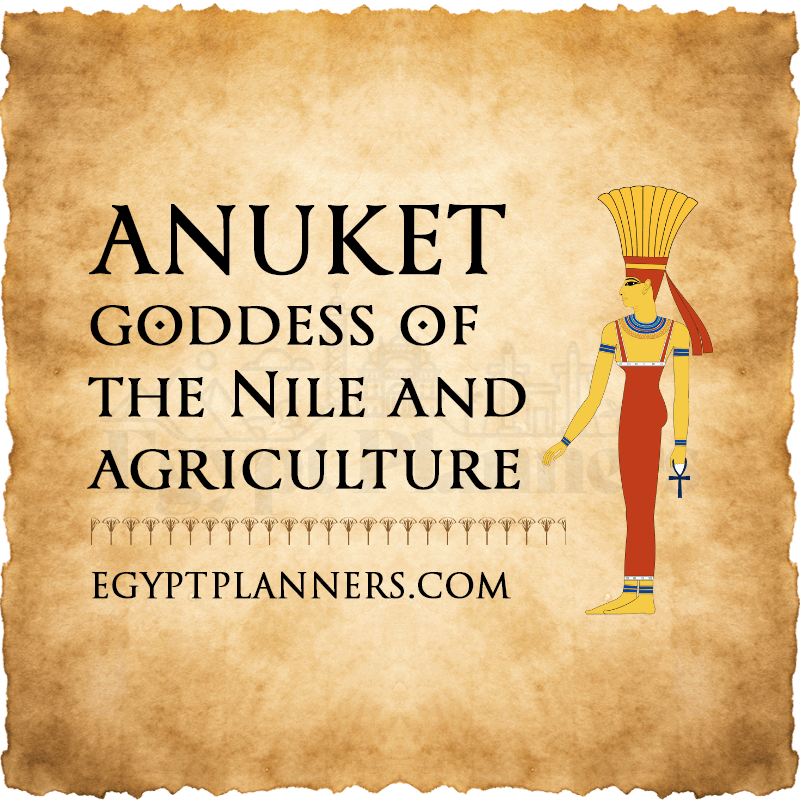
In ancient Egyptian mythology, Anuket is a key figure. She is linked to the Nile River and the crops it supports. As the goddess of the Nile and goddess of agriculture, Anuket was vital to the Egyptians.
The Nile’s annual flood was crucial for the land. It brought nutrients and water, making crops grow. Anuket was seen as a woman with a reed headdress or a feathered crown. These symbols showed her close tie to the river and its greenery.
Anuket was part of the Elephantine Triad with Khnum and Satis. Together, they represented the Nile’s life-giving power. Her symbols, the gazelle and scepter, showed her as a guardian and provider.
The Egyptians honored Anuket with rituals and festivals. They sought her help for good crops and land protection. Her stories often dealt with the Nile’s floods and Egypt’s safety.
The Egyptian pantheon was vast, with over 2,000 gods. While Isis, Osiris, and Horus are famous, Anuket is also important. She plays a key role in Egyptian mythology.
23- Hapi – The god of the Nile, fertility, and plenty

In the rich tapestry of ancient Egyptian mythology, Hapi is a key figure. He is the god of the Nile, the river that gave life to the civilization for thousands of years. As the god of fertility and plenty, his role was vital. His annual flooding of the Nile was essential for the land’s crops.
Hapi is often shown as a man with a big belly and breasts, wearing a headdress of aquatic plants. This shows his deep connection to the Nile and its waters. His main temple was in Aswan, near the Nile’s first cataract. There, he was honored for his role in keeping the land and people alive.
“Hail to thee, O Nile! Thou who has manifested thyself as Hapi, who comest to give life to Egypt.”
The Nile’s annual flooding was a time of hope and joy. It meant the land would be renewed and crops would grow well. Hapi, as the god of fertility and plenty, was seen as the source of this life-giving power. His worship was crucial for Egypt’s farming and wealth.
In Egyptian mythology, Hapi shows how important the Nile was to the ancient Egyptians. His legacy still fascinates scholars and fans today. They are drawn to the rich stories of this amazing civilization.
24- Khonsu – The God of the moon, time, and travelers
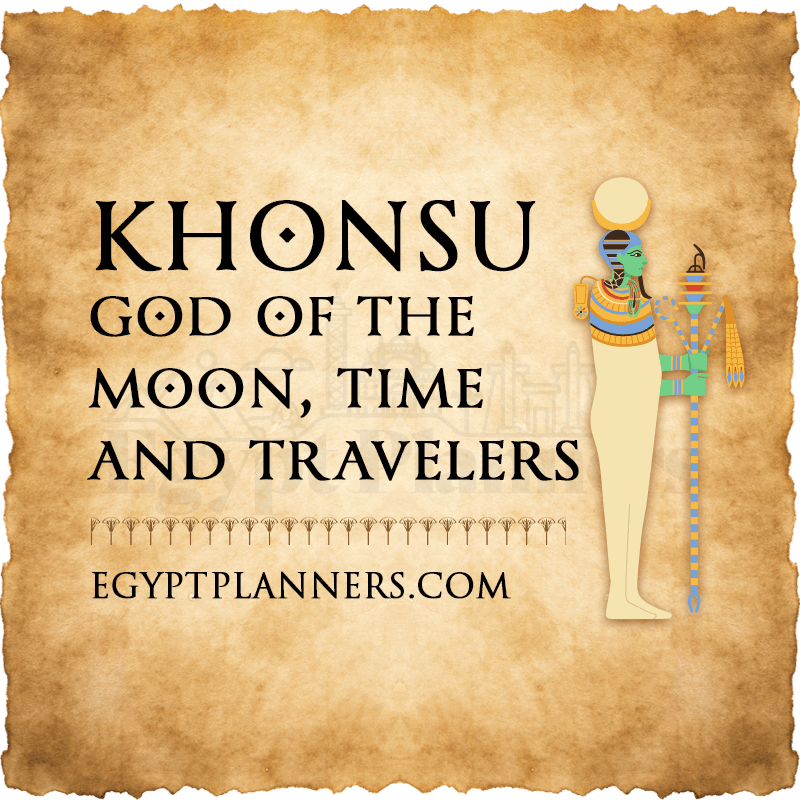
In ancient Egyptian mythology, Khonsu was a unique god. He was the god of the moon, time, and travelers. His influence was vast and deeply respected by the people of ancient Egypt.
Khonsu, meaning ‘traveller’, was the Egyptian god of the moon. He was part of the “Theban Triad” with Mut as the mother and Amun as the father. In the New Kingdom era, he became known as the “Greatest God of the Great Gods.” His cult centers were in places like Memphis, Hibis, and Edfu, showing his wide reach.
Khonsu was linked to the moon and its cycles. He played a big role in creation myths and temple complexes, especially in the Ramesside period. He was often shown as a young mummiform man with lunar symbols. This reflected his role as a gentle and compassionate god, especially in the New Kingdom.
Khonsu’s powers went beyond the moon and time. He was also seen as a protector of travelers and a guide on their journeys. This is shown in the Bentresh stela, which tells of a princess of Bekhten being healed by an image of Khonsu.
Khonsu’s legacy has also reached beyond ancient Egyptian mythology. He inspired Moon Knight in Marvel Comics. Moon Knight is the avatar of Khonshu and has supernatural abilities tied to moon phases.
Today, the temples and artifacts dedicated to Khonsu still fascinate scholars and fans. They offer a peek into ancient Egyptian mythology and the lasting impact of this remarkable god.
25- Neith – Goddess of hunting, war, and sewing.
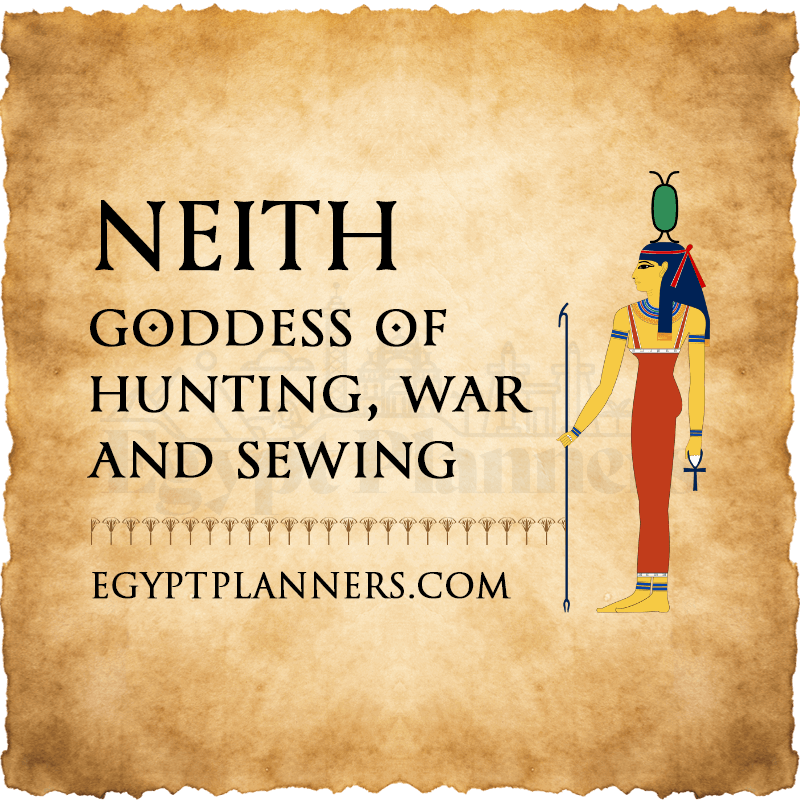
In ancient Egyptian mythology, Neith was a goddess of many roles. She was known for hunting, war, and sewing. Her worship began in the Predynastic era, around 6000 BCE. The city of Sais in the Nile Delta was her main place of worship.
Neith’s influence grew over time. By the Old Kingdom, her worship reached its peak. She was one of the oldest deities in Egypt.
Neith’s images show her as a woman with the red crown of Lower Egypt. She holds a bow and arrows, showing her as a warrior and huntress. She is also linked to weaving and sewing, as her hieroglyph looks like a loom.
Neith was seen as a powerful androgynous deity. She could give birth without a partner and was credited with creating birth itself. This made her a unique and powerful goddess in ancient Egypt.
Neith was also connected to Sobek, the crocodile god. She was often shown nursing a baby crocodile. This shows her role as a nurturing and protective goddess, caring for both humans and animals.
The worship of Neith, the Egyptian goddess, lasted for thousands of years. It was strong during the Old Kingdom, Middle Kingdom, and New Kingdom. Her temple in Sais was famous, with the inscription “I Am All That Has Been, That Is, and That Will Be.”
Neith’s influence went beyond Egypt. The Greek ruling classes saw her as similar to Athena. This made her a powerful and multifaceted deity in the ancient world.
| Key Facts about Neith | Details |
|---|---|
| Worship Period | Predynastic Egypt (c. 6000 BCE) to Ptolemaic Dynasty (323 – 30 BCE) |
| Cult Center | Sais in the Nile Delta |
| Associations | Hunting, war, sewing, creation, fertility, funerary rites |
| Symbols | Bow and arrows, sword and shield, weaving shuttle, Red Crown of Lower Egypt |
| Syncretization | Conflated with the Greek goddess Athena |
| Other Names | Net, Neit, Nit (meaning “the terrifying one” or “mother of the gods”) |
26- Min – The god of fertility, sexuality, and the harvest
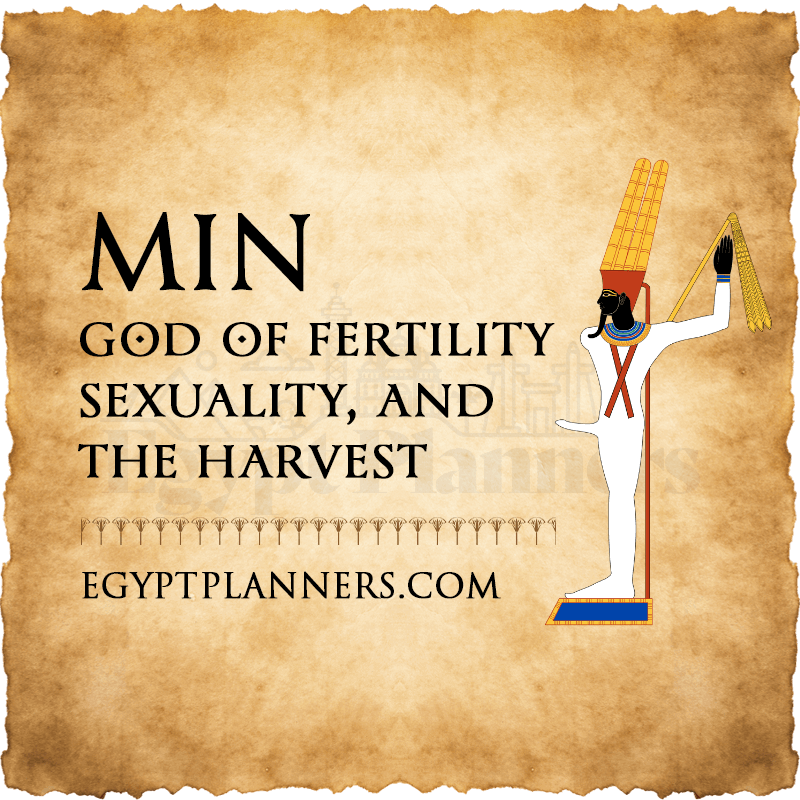
In ancient Egyptian mythology, Min was a god of fertility, sexuality, and the harvest. He was shown as a man with an erect phallus and a flail. This flail symbolized his power and kingship. Min’s main place of worship was Koptos, where he was seen as the protector of desert routes to the Red Sea.
His role in ensuring fertility of land and people made him very important. Min’s cult started in Koptos and Akhmim. There, grand festivals were held in his honor, with processions and offerings.
Min’s importance grew in the Middle and New Kingdom eras. He became closely tied with Horus and later with Amun as Min-Amun.
The Min Festival was a key event during the harvest season. His image was taken to the fields for rituals to bless the harvest. Offerings included lettuce and first fruits, with rituals for fertility or potency. Egyptian women even touched Min statues to promote pregnancy.
In Egyptian art, Min is depicted as a male deity with black skin, representing fertile soil. He holds his erect penis and a “flail”. His wives were Iabet and Repyt, with Isis being his mother and wife.
The worship of Min was sometimes controversial. Some festivals may have involved the pharaoh showing ejaculation to ensure the Nile’s flooding. Min was also closely associated with Horus until the Middle Kingdom, when he became more closely associated with fertility. Later, he was linked to Reshep, the Semitic god of war and thunder.
Throughout ancient Egyptian history, Min was revered as a god of fertility, sexuality, and the harvest. His role in the civilization’s religious and cultural practices is still fascinating today. His legacy continues to captivate scholars and fans of Egyptian mythology and ancient Egyptian gods.
27- Montu – The God of war, strength, and bravery

In ancient Egypt, Montu was a mighty god of war, strength, and bravery. He was shown as a man with a falcon or bull head, wearing a solar disk and uraeus. Montu was highly respected for his role in the military and his connection to the pharaohs.
Montu’s followers were in Thebes. They believed he gave power and protection to the Egyptian army and its leaders. As the god of war, Montu fought against those who opposed Maat, the goddess of truth and justice. His power was as strong as the sun god Ra.
Over time, Montu became even more important as a god of strength and bravery. Pharaohs like Thutmose III, Amenhotep II, and Ramesses II were seen as strong and brave like Montu. Some pharaohs even called themselves “Montu of the Rulers” or “Montu of the Two Lands.”
Montu played a key role in ancient Egypt’s military and protection. His legacy as a powerful war god and Egyptian military deity is still celebrated today. He inspires many, from art to thrilling rides.
| Attribute | Description |
|---|---|
| Depiction | Montu is usually depicted as a falcon-headed or bull-headed man with a solar disk and uraeus on his head. |
| Cult Center | Montu’s primary cult center was located in Thebes, with additional temples in Hermonthis and Armant. |
| Associations | Montu was associated with the sun god Ra, as well as the concepts of war, strength, and bravery. |
| Consorts | Montu had several consorts, including Raet-Tawy, Tjenenyet, and Iunit. |
| Importance | Montu was considered a symbol of the pharaohs as rulers, conquerors, and winners, particularly from the 11th Dynasty onward. |
28- Seshat – The Goddess of writing, knowledge, and understanding
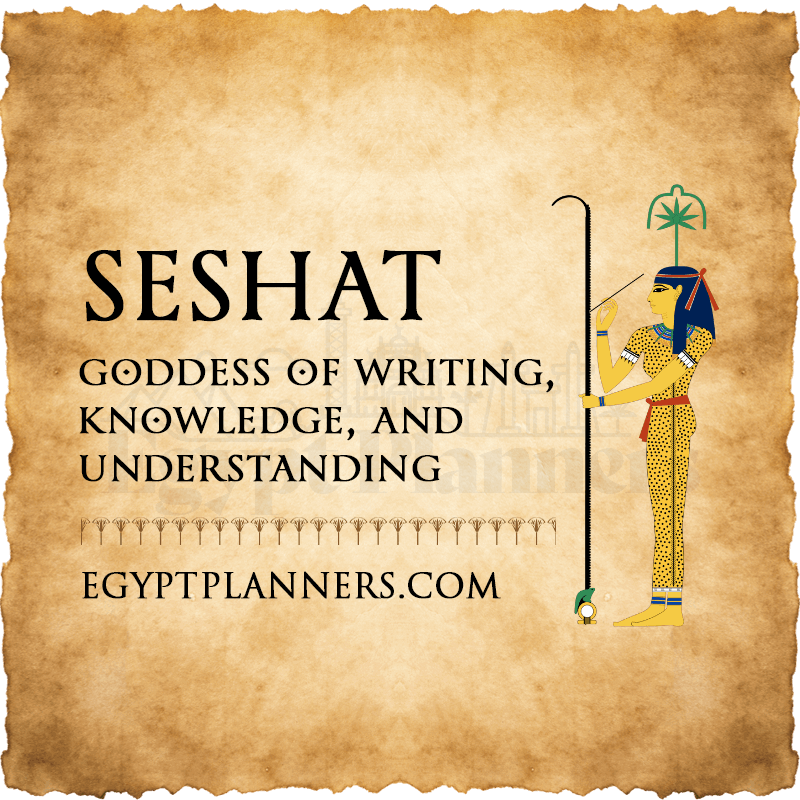
Seshat was a key goddess in ancient Egypt. She was known for writing, knowledge, and understanding. As the creator of writing, she helped keep Egypt’s culture and history alive.
Art showed Seshat as a woman with a special headdress. It had seven points, symbolizing the seven stars the Egyptians knew. This showed her connection to the stars and the universe.
Seshat did more than just write. She was also about science, math, and architecture. Her work with Thoth, the god of wisdom, made her very important for learning.
The Egyptians thought writing was magical. It could make things real. Seshat recorded important speeches and lists of goods won in battles.
She was also a guide for the dead. Seshat and Thoth helped spirits in the afterlife. They worked in the House of Life, a place for learning and writing.
Even though she wasn’t as famous as some gods, Seshat’s influence was huge. She was the goddess of writing, knowledge, and understanding. Her legacy is still celebrated in ancient Egyptian stories and beliefs.
29- Renenutet – The goddess of fertility and harvest
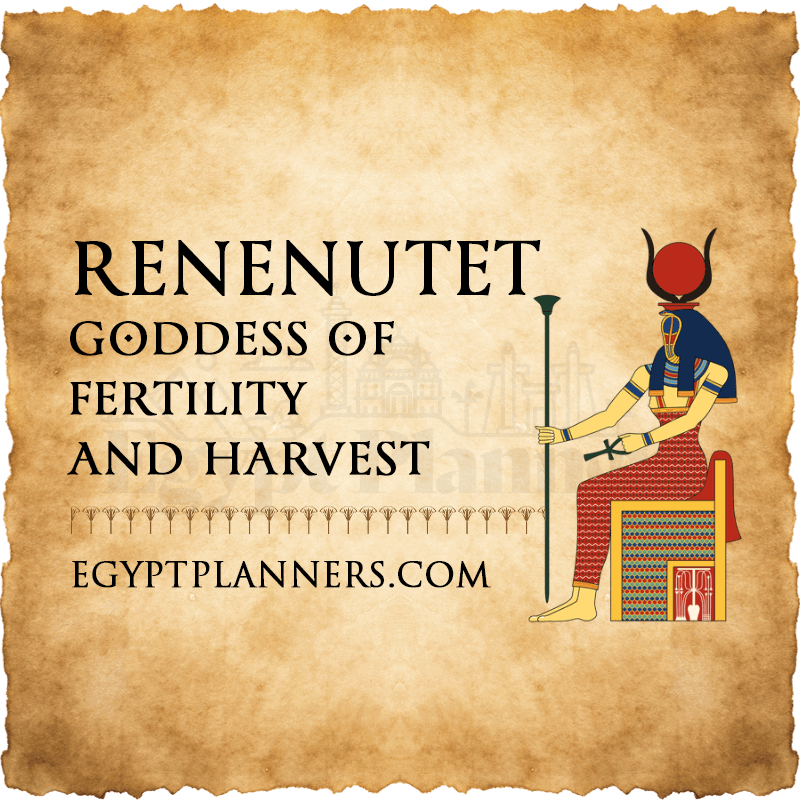
Renenutet was a key goddess in ancient Egypt. She was known for fertility and harvest. People saw her as a cobra or a woman with a cobra’s head.
She was very important in the Nile Delta. Here, she was seen as a goddess of plenty and wealth. She was linked to food like grain and grapes.
Renenutet was more than just a goddess of the land. She was also seen as the “nurse” of the pharaoh. She helped the pharaoh from birth to death. People offered her things during the spring and summer.
| Fact | Details |
|---|---|
| Renenutet’s Associations | Grain, grapes, nourishment, harvest, fertility, nursing the pharaoh, protection of the royal office and power |
| Cult Centers | Terenuthis, Narmuthis, Medinet Madi (shared with Sobek) |
| Depictions | Cobra, woman with cobra head |
| Other Deities | Wadjet, Meretseger, Isis, Hapi, Sobek |
| Festivals | Spring planting season, first month of summer season |
| Symbols | Water lilies, lotus flowers |
As time went on, Renenutet became more like other snake goddesses. She was seen as a form of Wadjet. Her role as an ancient Egyptian agricultural deity was huge. She was loved for making the land and people prosperous.
30- Serket – The Goddess of health and security.
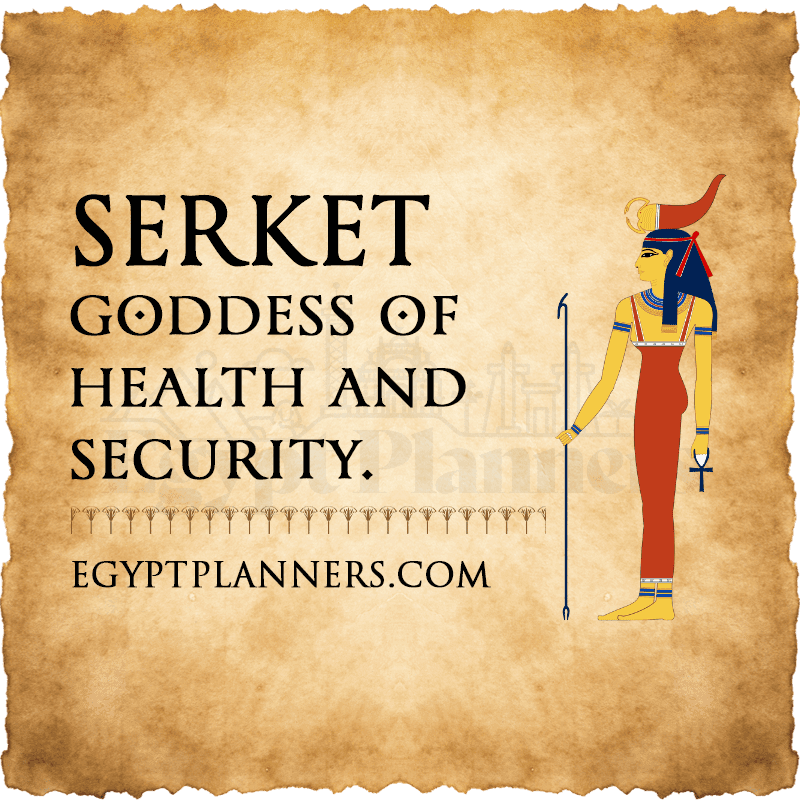
Serket, also known as Selkis, was a goddess in ancient Egypt. She was known for her powers of health and security. She was often shown as a woman with a scorpion on her head or as a scorpion itself.
People believed Serket could protect the pharaoh and others from scorpion stings and other dangers. She was also linked to mummification and guarding canopic jars. These jars held the internal organs of the dead.
Her cult was in the city of Behbeit el-Hagar in the Nile Delta. This shows how important she was in ancient Egyptian beliefs and practices.
As the goddess of health and security, Serket was very powerful. She was the protector of the pharaoh. This made her key to keeping the kingdom stable.
The ancient Egyptian scorpion goddess controlled the natural world. She kept both the living and the dead safe.
“Serket, the goddess of health and security, was a vital figure in the intricate web of ancient Egyptian religious beliefs and practices.”
| Attribute | Description |
|---|---|
| Goddess of Health | Serket was believed to have the power to protect people from scorpion stings and other dangers. This ensured their physical well-being. |
| Goddess of Security | As a protector of the pharaoh and others, Serket was crucial for the kingdom’s stability and security. |
| Scorpion Goddess | Serket was often shown with a scorpion on her head. This reflected her connection to the scorpion and her role in protecting against its venom. |
| Mummification and Canopic Jars | Serket was believed to guard the canopic jars that held the organs of the deceased. This made her important in mummification and the afterlife. |
31- Wepwawet – The God of war, hunting, and kingship
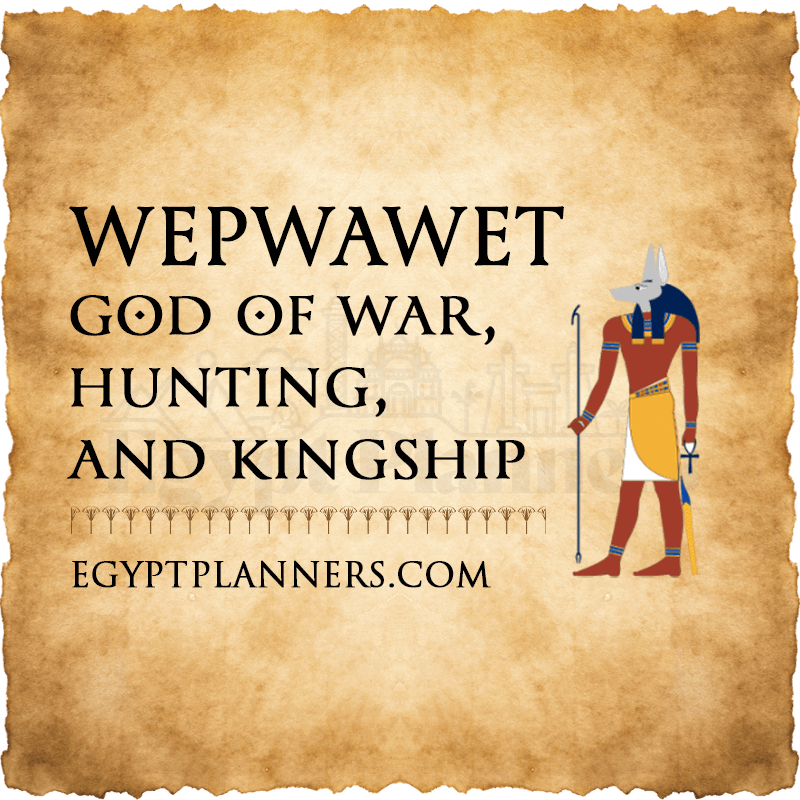
Wepwawet, also known as Upuaut, is a fascinating figure in ancient Egyptian mythology. He was a god of war, hunting, and kingship. Often shown as a jackal or a man with a jackal head, he protected pharaohs and guided the dead to the afterlife.
His cult was in Asyut, and he was key in the Egyptian pantheon, especially in the Old Kingdom and First Intermediate Period. As a god of war and hunting, Wepwawet led armies and helped pharaohs in battle. He also guided souls to the afterlife.
Wepwawet became linked with Anubis, seen as his brother. In later art, he carried military gear like a mace and bow. This showed his link to warfare and the pharaoh’s power.
Wepwawet’s importance in ancient Egyptian mythology is clear. He was tied to the Pharaoh and played a big role in rituals. He was crucial in the Opening of the Mouth ceremony, helping souls into the afterlife.
“Wepwawet embodied roles in both the realm of the living as a slayer and in the afterlife as the rebirthing agent of kings.”
The many ways Wepwawet is shown in art and his link to the African wolf show his complex nature. This ancient Egyptian god of war, hunting, and kingship was deeply important in ancient culture and spirituality.
32- Heqet – The Goddess of fertility, rebirth, and renewal
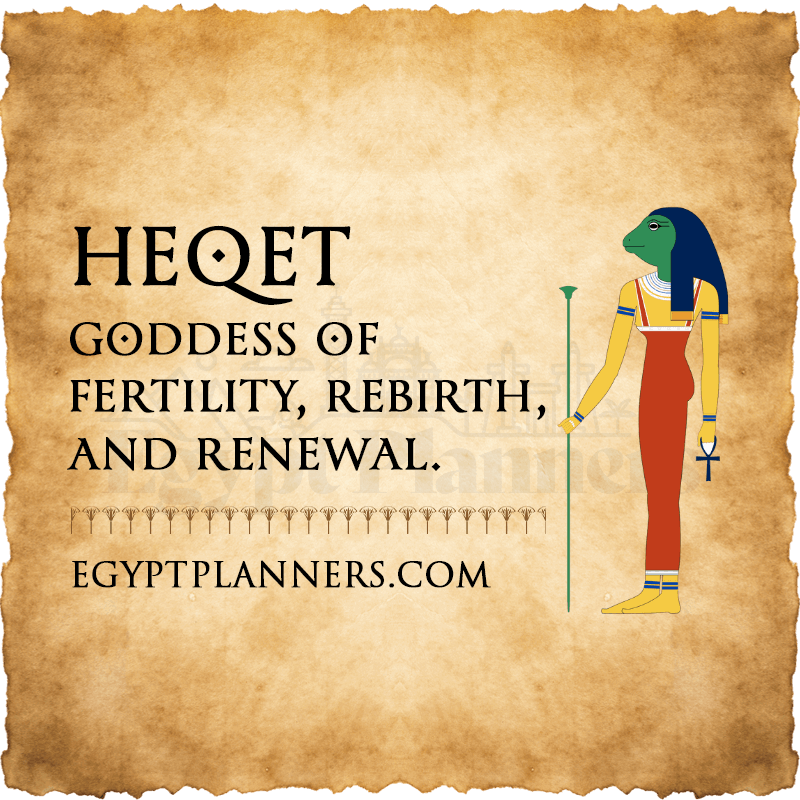
In ancient Egypt, Heqet was a special goddess. She was all about fertility, rebirth, and renewal. People saw her as a woman with a frog’s head or just a frog. This made her a symbol of the Nile River’s power and the cycle of life.
Heqet was very important for fertility and childbirth. She helped with births and gave life to mothers. Her home was in Behdet, Upper Egypt. People prayed to her for fertility and new life.
| Heqet’s Significance | Attributes and Associations |
|---|---|
| Goddess of Fertility | The frog, a symbol of fertility and regeneration |
| Goddess of Rebirth | Collaborating with deities like Khnum and Osiris in rituals celebrating life and resurrection |
| Goddess of Renewal | Linked to the annual flooding of the Nile, a crucial element in Egyptian agriculture |
| Deity of Childbirth | Invoked by expectant mothers through rituals and prayers for protection and aid during labor |
The ancient Egyptians loved Heqet for her power in nature. Her symbols were everywhere, from helping pregnancies to helping in funerals. Even today, people still honor her in rituals about fertility and rebirth.
“Heqet, the ancient Egyptian frog goddess, was a symbol of life, fertility, and renewal, embodying the eternal cycle of regeneration that was so crucial to the Egyptian way of life.”
33- Bes – God of safety, happiness, and childbirth
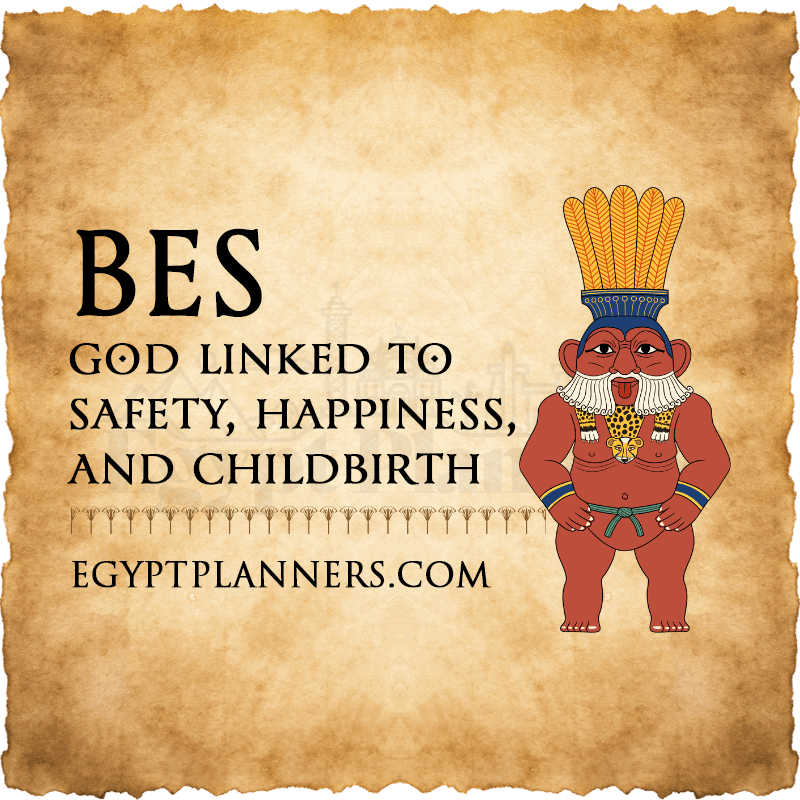
Bes was a unique god in ancient Egypt. He was the god of safety, happiness, and childbirth. He was shown as a dwarf with a strange face.
Bes was known for keeping evil spirits away. He protected homes, especially women and children. He brought joy and good luck, loved music and dance.
People offered food and flowers to Bes. His influence is still seen today in art and stories. He is still a fascinating figure to many.
Bes looked different from other gods. He had a lion-like face and was short. He focused on family safety and happiness.
Icons and amulets with Bes were used for protection. His role in childbirth and family safety was key in ancient Egypt.
Bes was especially important during childbirth. His image was placed near the mother to keep evil spirits away. This made him even more beloved.
Bes symbols were everywhere in ancient Egyptian homes. This shows how much people believed in him. He was a big part of daily life, from jewelry to decorations.
34- Satis – Goddess of the Nile River and its wealth
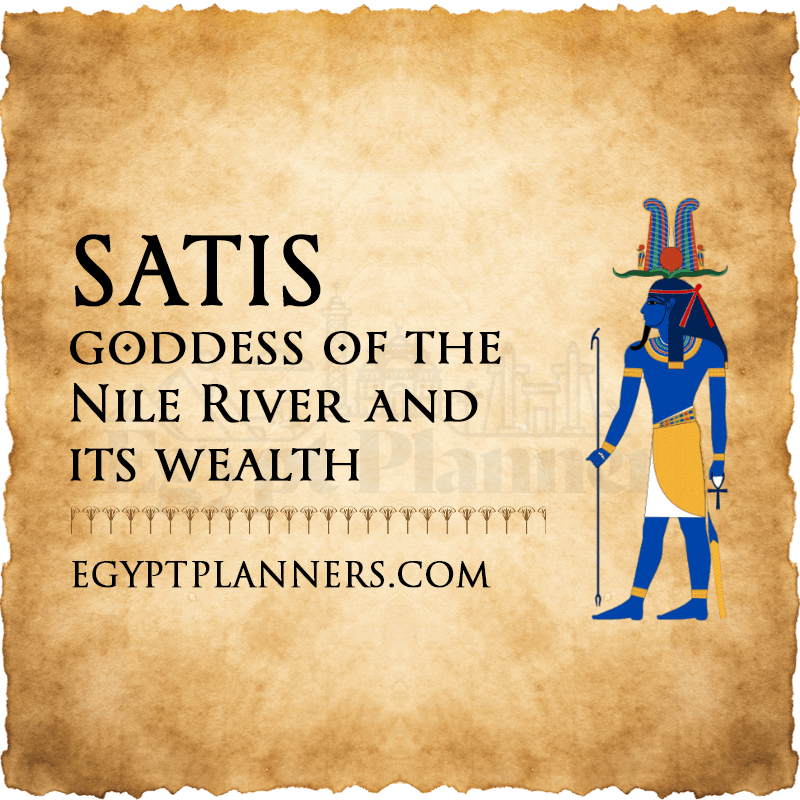
In ancient Egypt, Satis was a key goddess. She was the goddess of the Nile River and its wealth. She was shown as a woman with the crown of Upper Egypt and carried a bow and arrow.
Satis was also known as the goddess of the Nile River and the goddess of Nile River wealth. She was seen as a symbol of fertility, abundance, and the Nile’s life-giving power. Her worship was centered on Elephantine Island, where she was joined by Khnum and Anukis, forming the Elephantine Triad.
As an ancient Egyptian deity of the cataract region and a protector of Upper Egypt, Satis was highly respected. She was linked to the Nile’s annual flooding, which brought wealth and food to the land. Her role as a guardian of Egypt’s southern border showed her importance in keeping the region safe and stable.
“Satis was a goddess of fertility, abundance, and the life-giving power of the Nile River, a vital resource for the ancient Egyptians.”
The worship of Satis started in the early dynastic period, with signs of her cult from the Third Dynasty. Over time, her importance grew as the Egyptians realized how crucial the Nile was for their farming and economy.
Through her connection to the Nile’s wealth and her protective role, Satis became a vital part of the ancient Egyptian pantheon. She helped ensure the prosperity and stability of the region under her divine watch.
35- Tatenen – God of Creation, Earth, and Fertility

In ancient Egyptian mythology, Tatenen is a key figure. He is seen as the god of creation, the earth, and fertility. He came from the chaos waters and symbolizes the Nile Valley’s fertile lands.
Tatenen is often shown as a man with the double crown of Upper and Lower Egypt. This shows his role as a creator god and a deity of the earth. His connection to the Nile Valley’s green soil is key to ancient Egyptian farming.
In Memphis, Tatenen was worshipped alongside Ptah. Together, they represented the creative and generative powers of nature. Tatenen’s role in creating the earth and bringing life back ensured the cycle of existence and renewal.
The Festivals of Tatenen, like the Feast of Tatenen, honored the god of fertility. They celebrated the earth’s abundance. These festivals highlighted Tatenen’s importance in ancient Egyptian life and spirituality.
FAQs About Ancient Egyptian Gods And Goddesses And Their Powers
What Is The Most Powerful Egyptian God?
Ra, the sun god, is often considered the most powerful Egyptian god. He is the creator of all life and the ruler of all gods, ensuring the sun rises each morning.
How Powerful Are Egyptian Gods?
Egyptian gods were immensely powerful, influencing natural events and human life. They controlled everything from the weather to individual fates in the afterlife.
Is There A Difference Between Egyptian Gods Powers And Egyptian Goddesses?
Both gods and goddesses had immense powers, often reflecting different aspects of life. Gods like Ra and Osiris focused on creation and the afterlife, while goddesses like Isis and Hathor embodied nurturing, magic, and love.
What Are The Most Important Gods And Goddesses of Ancient Egypt?
Important deities include Ra (sun god), Osiris (god of the afterlife), Isis (goddess of magic), Horus (god of kingship), Anubis (god of mummification), and Hathor (goddess of love and joy).
Who Is The Most Powerful Egyptian Goddess?
Isis is often considered the most powerful goddess, known for her magic, healing abilities, and protective nature. She resurrected Osiris and ensured Horus’s rise to kingship.
Conclusion About Egyptian Gods And Goddesses And Their Powers
The ancient Egyptian gods and goddesses form a fascinating tapestry of mythology that continues to captivate the imagination of people around the world. These deities, each with their unique attributes and stories, played crucial roles in shaping the beliefs and daily lives of the ancient Egyptians.
From the all-powerful sun god Ra to the protective and nurturing Isis, and from the underworld ruler Osiris to the wise Thoth, these gods and goddesses were integral to understanding the universe and the human condition. As we explored their myths and significance, it becomes clear how deeply embedded they were in every aspect of Egyptian life, from governance to death rituals, and their influence persists even in modern culture and media.
We encourage readers to delve deeper into the enchanting world of these ancient deities. There is so much more to discover about their stories and the incredible temples and artifacts dedicated to them. Consider visiting Egypt to witness firsthand the awe-inspiring temples of Karnak, Luxor, and Abu Simbel, and the wealth of treasures housed in museums like the Egyptian Museum in Cairo and the Luxor Museum.
You can learn more about the history of ancient Egypt through our following article:
- Eye of Horus vs Eye of Ra
- Anubis Egyptian Dog God
- Top 5 Egyptian Symbols for Power
- Top 8 Egyptian Symbols for Strength
- Top 15 Ancient Egyptian Good Luck Symbols
- Top 28 Egyptian Symbols Of Protection
- Revered Animals in Ancient Egypt NYT
- List of Famous Egyptian Queen Names
- Ancient Egyptian Amulets and Their Meanings
- Egyptian Scarab Beetle Symbol Meaning
- Ancient Egyptian Goddess Bastet
